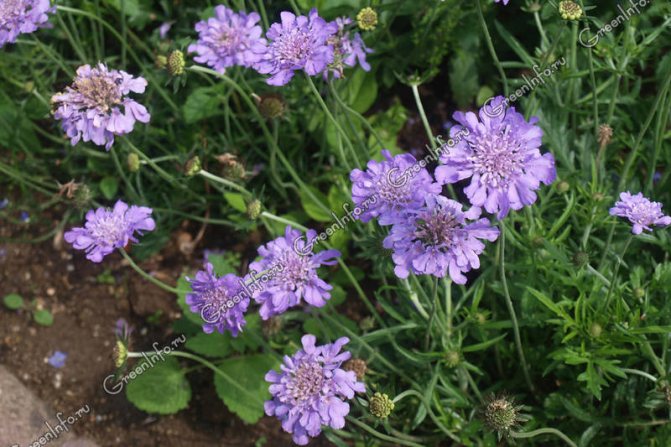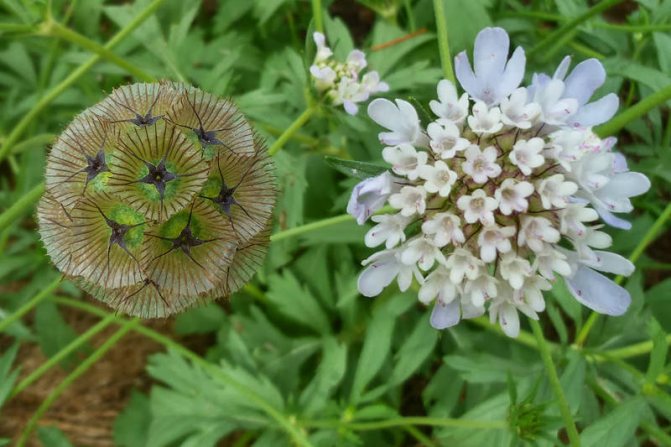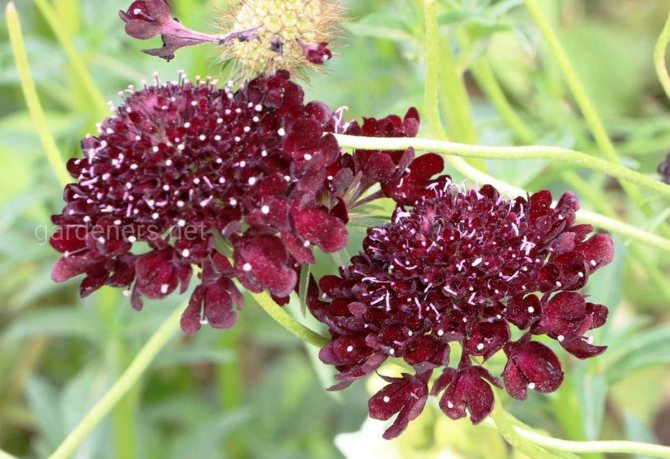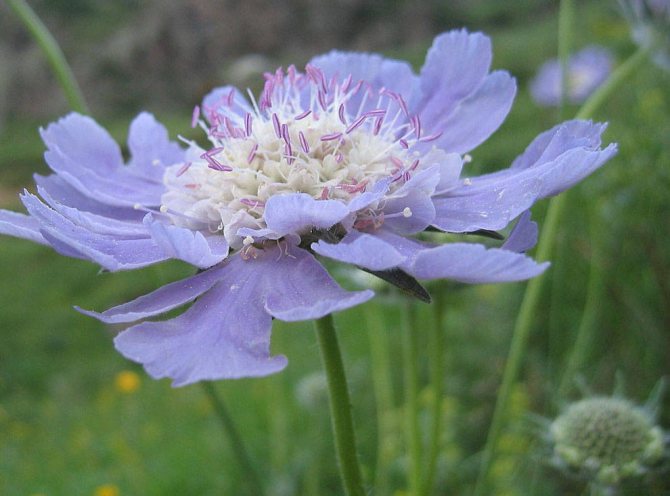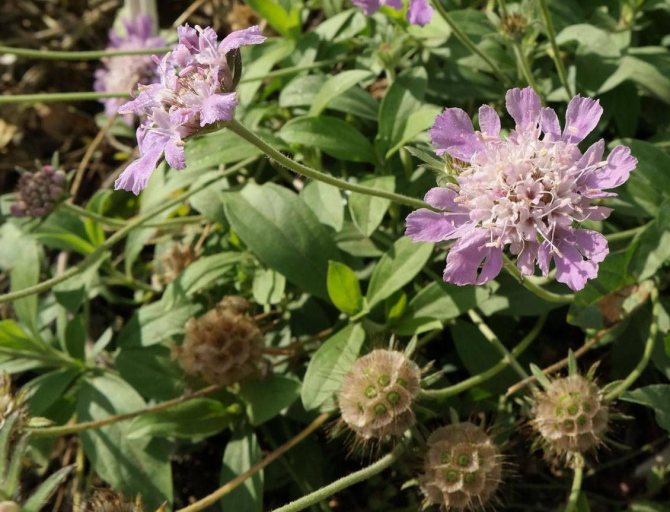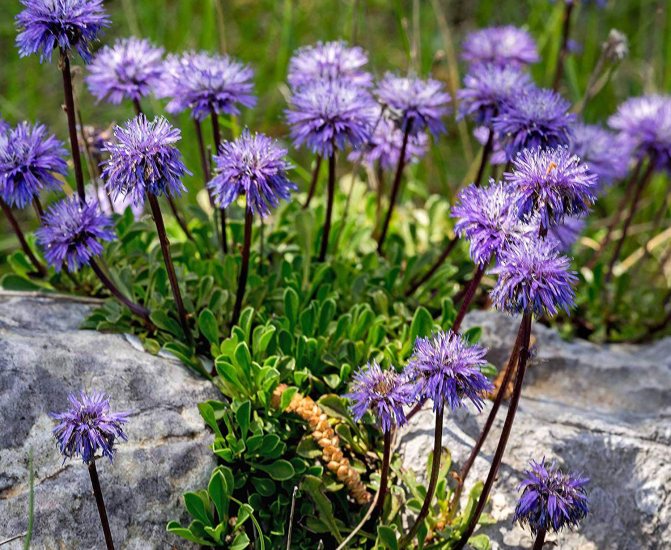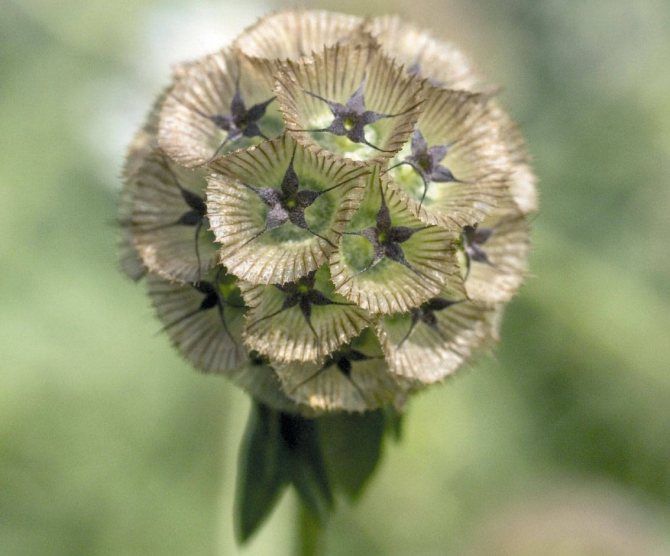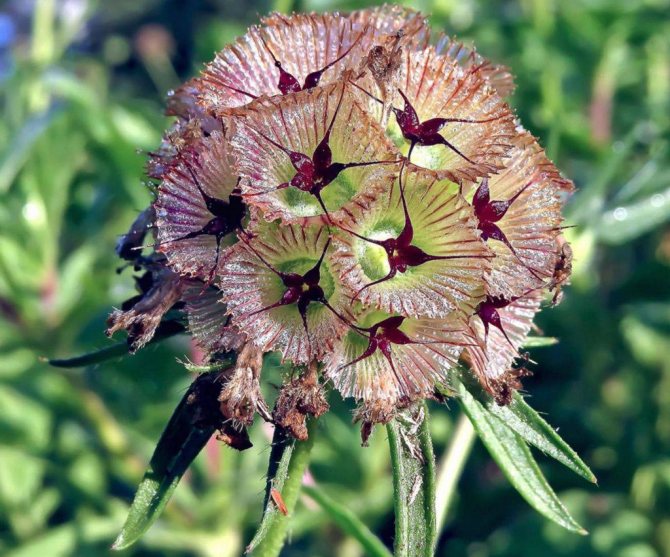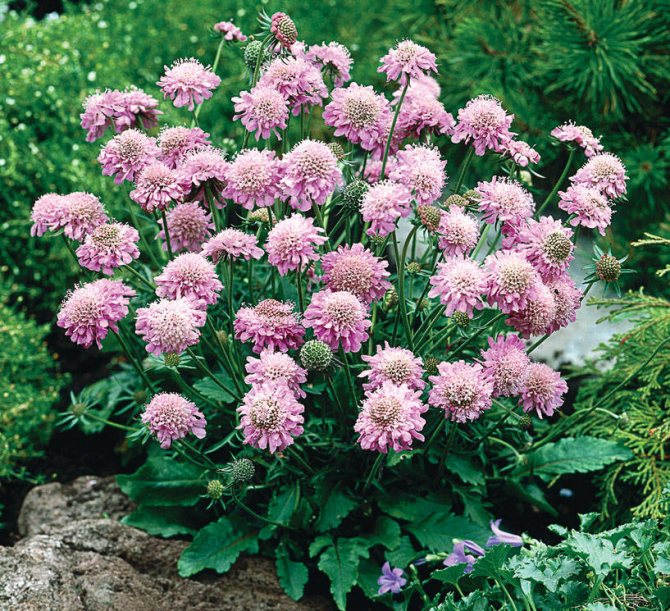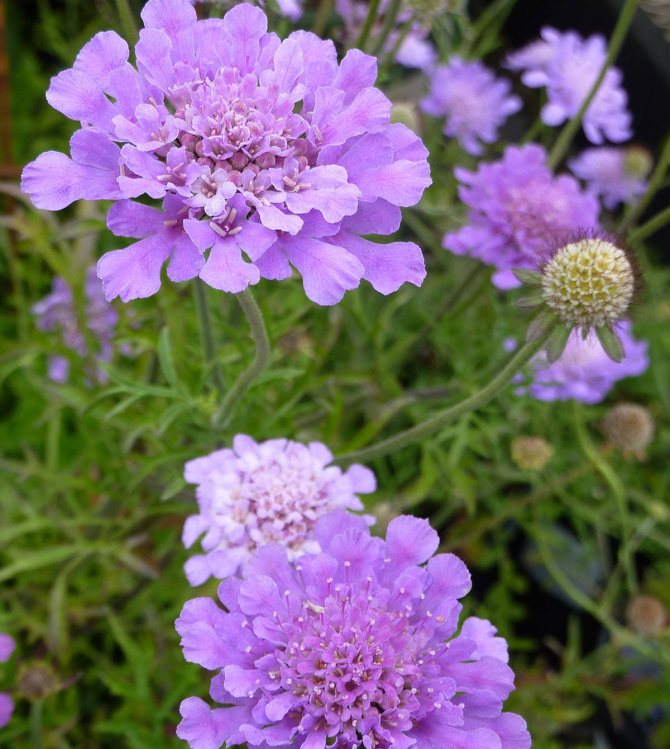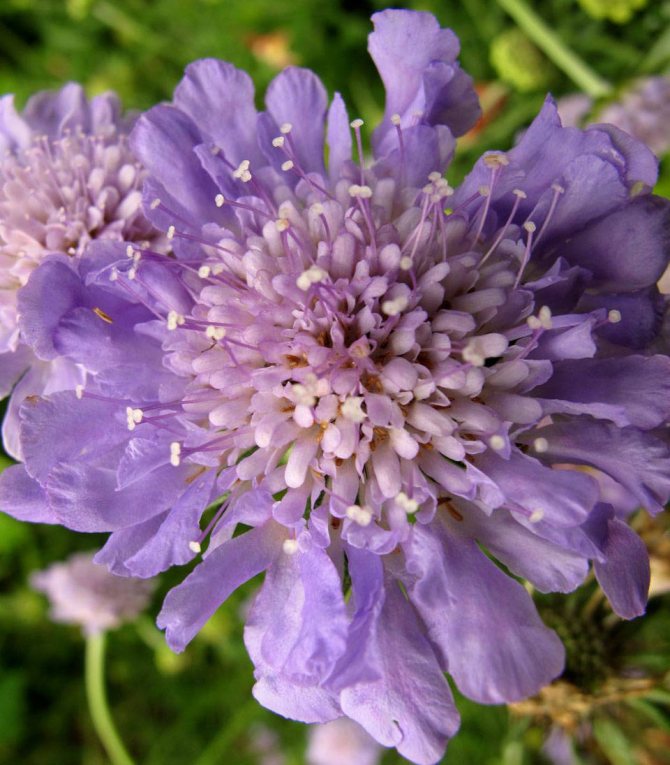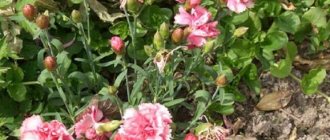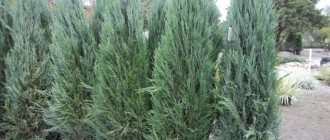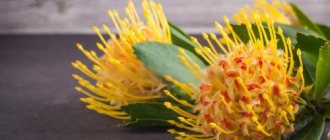The modest charmer - scabiosa - is familiar to most gardeners. Its small, but bright flowers adorn many household plots. This beautifully flowering representative of the decorative flora looks very harmonious: a dense rosette of carved leaves is crowned with tall shoots with buds. Blooming, the buds turn into fluffy balls-inflorescences of various shades: white, pink, blue, lilac. Scabiosa blooms for a long time and gives its beauty almost all summer.
Scabiosa is distinguished not only by its pleasant appearance, but also by its docile nature. It is not difficult to grow it: the plant needs to be watered sometimes, lightly fed and replanted from time to time. The flower tolerates the climate of the temperate zone of our country well, however, some species, whose homeland is subtropics, in more northern regions can only be cultivated as annuals. In general, we can say that scabiosa is perfect for everyone, including the most inexperienced gardeners.
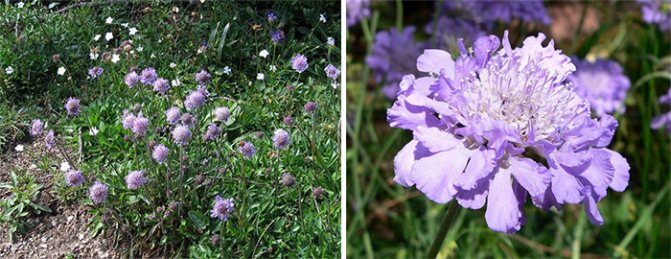
Scabiosa, at least one species, is a medicinal plant often used in Tibetan folk medicine. She is treated for colds, sore throats, diseases of the lungs and heart, skin ailments. In addition, the flower is very attractive to beneficial insects: butterflies, bees, bumblebees and is considered an excellent honey plant. Well, the most important thing for which it is worth growing scabiosa is the attractive beauty of a gentle shy woman.
The name of this wonderful flower comes from the Latin word that translates as "itching" or "scabies" (it is believed that the plant cures this skin ailment). According to another version of scabiosa, it is "rough" or "bumpy", which indicates rough bracts. Popular names of the culture are also associated with its structural features and medicinal properties - scabies cornflower, navel, pinecone. In English-speaking countries, the flower is called a pincushion or devil's root. Legend has it that the devil, annoyed by the beauty of the flower, wanted to destroy it by biting the root. Scabiosa survived, but since then its root has no end and resembles a stump.
The homeland of the plant is considered to be South and Central Europe, the mountains of South Africa and Central Asia. In our country, wild scabiosa is most often found in the Caucasus, although individual specimens can be seen throughout the entire European part of Russia. The flower prefers to settle in dry meadows, in the mountains, foothills and other open sunny places with rocky soil.
Botany classifies scabiosa (Latin Scabiosa) to the honeysuckle family (Latin Caprifoliaceae), or rather to the subfamily of teasers (Latin Dipsacoideae). Its closest relatives, known in ornamental floriculture, are capitate, teasel and syvets.
The genus includes at least 100 species, both annual and perennial grasses and dwarf shrubs.
[!] Some species that were previously considered scabioses are now classified as a separate genus Korostavnik. So, for example, the field and Macedonian scabiosa, popular in ornamental floriculture, are now called the field and Macedonian korostavnik.
All plants of the genus have several common features: a branched rhizome, simple or branched erect strong shoots, opposite leaves of a pinnate, toothed or lobed shape. At the ends of long peduncles, flowers appear, collected in inflorescence-heads in the form of a slightly flattened ball.Their color can be very different: white, cream, pale or bright pink, purple. Each inflorescence is framed by a bracts of short leaves. After flowering, the fruit appears with a large number of small black seeds.
Large cores of Scabiosa inflorescences
Scabiosa inflorescences are like a bridal bouquet. The reed flowers form a "substrate" for the bouquet, and a large central disc of small flowers is the bouquet itself. The plant easily tolerates both cold and heat, and also does not require much effort to care for, giving long-lasting bright flowering.
Scabiosa genus
Among the hundreds of plant species united by botanists in the genus Scabiosa, there are perennial shrubs and one or biennial herbaceous plants in nature. The number of cultivated plants is 5 times less than those growing in the open space. The best sides of the plant are fixed in the garden forms, and therefore among them there are large-flowered species, as well as undersized specimens.
When you look at the photo of the capitate inflorescence of Scabiosa, you get the feeling that you have already seen similar flowers, but with a different name. But, if you put these flowers together and compare, then, naturally, you will see clear differences. The photo below shows the inflorescences (from left to right): Scabiosa, Iberis, Astrantia, the general outlines of which are similar, but the small details are very different.


Even in the photo, one can feel that Astrantia's extreme flower-petals are as hard as paper. It seems, touch them, and they rustle. And the extreme ligulate flowers of Scabiosa are soft and lively. And about Iberis - and say nothing.
True, the pronounced central disc of the Scabiosa inflorescence is lost in hybrid varieties with double inflorescences, characterized by a variety of intermediate shades of blue, violet, purple, as well as from white to pink and red. And the marginal petal flowers sometimes have completely different colors on the outside and inside.
You can meet other "folk" names of the plant, for example, Korostovik or Widow.
Varieties
* Caucasian scabiosa (Scabiosa caucasica) - pubescent erect stem of a herbaceous perennial plant grows up to 80 cm. Leaves of Caucasian scabiosa are of two types: broad-lanceolate or elongated-oval - basal and pinnately dissected - stem. Flat large inflorescences are collected from small flowers, painted in lilac, blue, white. Flowering lasts the last two months of summer.
* Scabiosa dark purple (Scabiosa atropurpurea) - fragrant compact annual (sometimes biennial) with bright dark purple, pink, purple, white funnel-shaped inflorescences. The leaves are also of two types: on the stem, the leaves are pinnate, and the basal ones are broad-leaved. It is popular with gardeners, easily tolerates a transplant, regardless of the age of the plant.
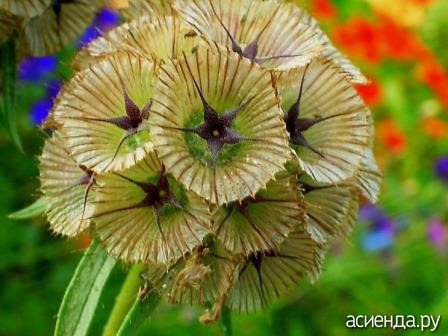

* Scabiosa brilliant (Scabiosa lucida) - a low bush (up to 30 cm) with lilac-pink inflorescences.
* Scabiosa graminifolia is a 40-centimeter shrub with narrow leaves and purple inflorescences.
Growing
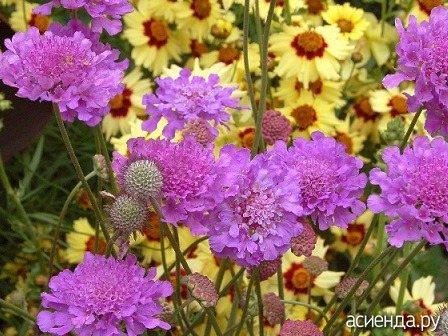

Cold-resistant Scabiosa is grown outdoors, using it in mixborders; arranging flower borders out of it; undersized species look great in the alpine slides. Scabiosa is also suitable for cutting.
The plant loves the sun and fertile soils, non-acidic and moist. Watering is required during dry periods.
To make the flowering lasting, cut off the faded peduncles at the level of the first node, and in the fall - at the root.
Perennial species lose their decorative effect over time, therefore it is recommended to replace the plant with a new one every five years.
Reproduction
Annuals and perennials are propagated by spring sowing of seeds. The latter, in addition, can be propagated by dividing the bush, which is usually carried out in the fall.
Enemies
With an excess and stagnation of moisture in the soil, fungal diseases can prevail.
The most important enemy is powdery mildew, which covers the leaves with a white powdery coating, leading to the death of the plant.
Diseases and pests
Teasel is not particularly susceptible to infections and other diseases, however, excessive watering or swampy areas can lead to the rapid development of fungal diseases. If traces of rot are noticed, watering should be stopped immediately, loosened up the soil and removed all weeds so that the planting is well ventilated. By the way, weeding for this culture is an important point of care.
Powdery mildew damage is possible due to the transfer of pathogens by insects or gusts of wind. If the air temperature is below + 20C, and at the same time there is high humidity, the disease can progress quickly and destroy the landing in a short time. If signs of infection are found, chemicals with the presence of sulfur should be used, repeating the treatment after a week.
Another way to combat powdery mildew is mullein, diluted 1:10, with the addition of urea (1 tablespoon per bucket). Processing is done twice at once - in the morning and in the evening.
Scabiosa flowers are cut for a long time, keeping freshness for up to 5-7 days.
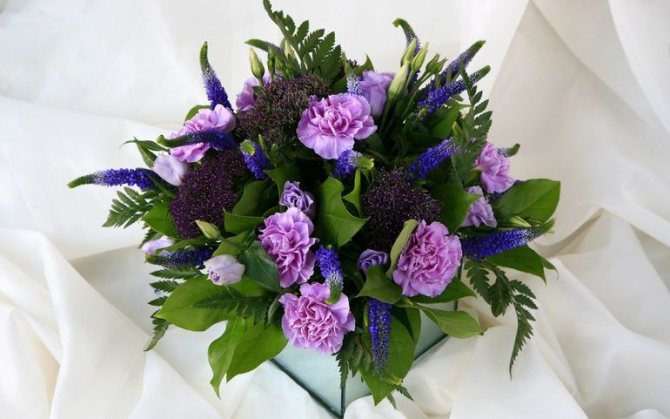

Scabiosa in a bouquet
Such a different scabiosa
The market in Russia offers perennial and annual representatives, they are from 20 to 80 centimeters in height, they have impressive flower stalks.
Perennial scabiosa has large flowers of white or pale blue, reaching 10 centimeters in diameter... The flowers are lush, attractive, of an original and exquisite shape, thanks to which they are awarded the attention of artists. Annual scabiosa is more often pink, white, blue, and sometimes red, with flowers up to 7 centimeters in diameter. This plant pleases with its beauty from June to September, depending on when it was planted, it has a peculiar charm that makes the flower an ideal companion in compositions with stones, cereals, herbs.
Scabiosa can often be found in group plantings, in wedding bouquets, mixborders.
How to grow scabiosa properly
Scabiosa flowers can be grown in seedlings or immediately planted in open ground.
Sowing seeds in open ground
The seeds of the annual scabiosa retain their qualities for a long time. With the onset of early spring, the seeds of scabiosa flowers are sown. In some regions, seeds can be sown in mid or even early April.
Before sowing scabiosa seeds, it is necessary to moisten the soil. The seeds themselves cannot be buried deep in the soil. After sowing, the seeds are covered with a layer of earth, and on top, it is recommended to put a small (5-10 mm) layer of compost. Scabiosa is a cold-resistant plant, so when sowing seeds in open ground, you should not worry about night frosts.
Scabiosa seedlings appear 1.5 weeks after planting the seeds. After waiting for the plants to grow a little, the seedlings will become strong, it is necessary to thin out the plantings, leaving only healthy specimens, and the frail ones need to be thrown away.
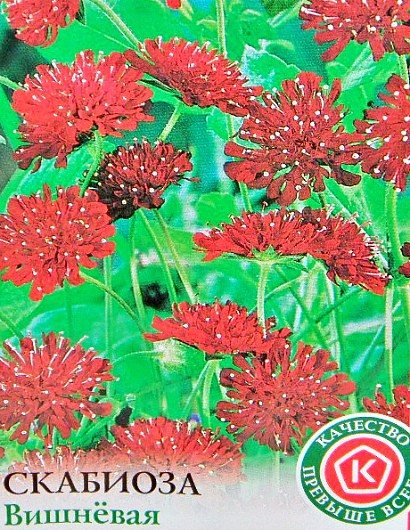

How to grow scabiosa seedlings
When and how to plant
Sowing seeds of perennial scabiosa for seedlings can be carried out from February or early March. We sow seeds only in fertile soil. After sowing, the soil is moistened, the containers with the plantings are covered with glass or polyethylene. Boxes with seedlings are kept in a warm room at a temperature of + 15 degrees. Every day it is necessary to inspect the plantings, ventilate, removing the film for about 1 hour. During this time, the condensation will evaporate and the boxes can be covered again.
Dive
On the 7-9th day, when the first shoots hatch, the glass must already be removed. It is recommended to moisten the soil from a spray bottle by fine spraying. When the plants get stronger and 2 real and strong leaves appear on them, we dive the seedlings into separate cups or boxes.The distance between plants in a row should be 5 cm.
Before planting seedlings in the ground, the seedlings are hardened. To do this, you need to take out boxes with plants in the garden or on the balcony. At night, boxes with seedlings are brought back into the house.
Planting scabiosa seedlings in open ground
It is recommended to transplant seedlings to a flower bed at the end of May at the beginning of June. For planting, choose a well-lit area and prepare the soil. For scabiosa, neutral soil with good drainage (water drainage) is preferable. Before planting, it is recommended to fertilize the soil with manure: add one bucket of manure to 1 square of soil. We plant the seedlings, trying to maintain a distance of 20 cm from each other.
Transplant nuances
- The best place to plant scabiosa flowers is in the center of the flower bed.
- Perennial varieties must be protected from night frosts and strong winds.
- Scabiosa loves the sun, respectively, the site that is selected for planting should be illuminated by the sun all day long.
Scabiosa care
Watering
Water the scabiosa in moderation. Re-watering is carried out only after the surface layer has dried. If the soil is waterlogged, the root system will die. Scabiosa flowers grown from seeds tend to prefer drier places than too humid ones.
After watering the soil, as well as, in rainy weather, when there are prolonged rains, the soil near the plants must be loosened. This will provide oxygen to the roots and allow the plants to thrive.
What to feed
For feeding, it is necessary to use phosphorus-potassium fertilizers. In response to the fertilizers applied, the scabiosa reveals itself in all its glory: the color of the flowers acquires richer shades, becomes bright, the flowers themselves bloom to enormous sizes.
How to deal with powdery mildew
A fairly resistant plant, almost never exposed to an invasion of pests, it is not prone to infectious and fungal diseases. Sometimes, with highly moistened soil, with thickening plantings and poor ventilation, the plant can get sick with powdery mildew.
You can understand that the plant is sick by the leaves, with the appearance of a coating in the form of flour on them. The leaves become covered with specks, which even become transparent, as if they were damaged by some hot object. Actellik and Topaz are recommended to fight the disease. Chemicals are used in accordance with the instructions, the dosage should not be exceeded. Damaged foliage is removed from the plant before treatment. The remains are incinerated.
It should be noted that Actellic is a rather unpleasant insecticide. When spraying, it irritates the upper respiratory tract. To reduce the effects of the poison on the body, the treatment is carried out in calm, calm weather or work in a respirator. After processing with Topaz, whitish stains remain on the foliage. But when the drug is absorbed into the foliage, the streaks disappear on their own.
Flower propagation
Common methods for obtaining new copies of scabiosa are seed reproduction and division of the bush. Seed reproduction is carried out in May, and the division of the bush is done early in the spring, even before the plants start growing.
Perhaps nothing can be better than beautiful flowers at home, grown with your own hands. Today we will talk about the scabiosa plant (or korostavnik), which is considered a perennial and adorns the flower beds of summer residents with its flowering all summer.
Scabiosa is a plant of the Vorsyankov family. The stems can be up to one meter long. The stems can be branched, as well as erect (depending on the variety). All species have inflorescences that are collected in bunches. It is noteworthy that the flower is very fond of warmth. There are more than a hundred types of scabiosa that have been artificially bred.
Korostavnik, photo of a plant
Varieties of korostavnik
So, the most famous types of scabiosis. Pigeon scabiosa
- This is a plant that is very rare in nature.Wet soil and slopes near rivers are the element of a flower. The leaves are oblong. Flowering begins in July, and flowering ends in September.
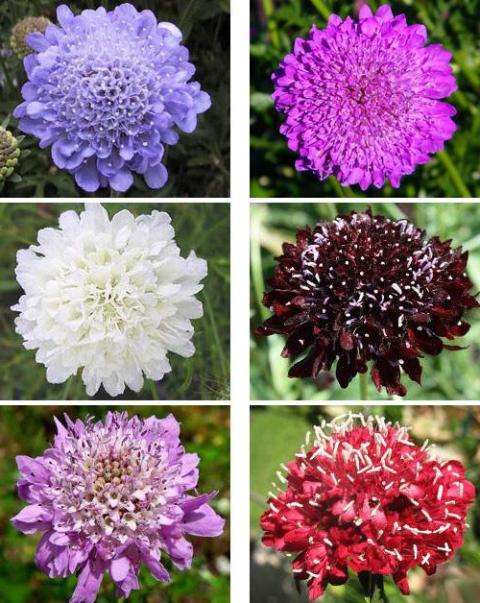

There are a lot of flowers Caucasian scabiosa
... The plant is striking in its versatility. There are pink, purple, blue shades and many others. The flower can reach 7 centimeters in diameter. Very often, Caucasian scabiosa is used in landscape design.
It looks quite attractive cereal-leaved scabiosa
... Mainly grown from seed.
Scabiosa flower
No plant will decorate your garden like scabiosa. It should be noted that the plant does not require special care. In order to grow scabiosa, it is necessary to select a sunny area. In this case, the soil must be carefully selected. The best option is fertilized soil with a good drainage system.
Around April you can plant scabiosa seeds in open ground
... The plant is planted at a distance of 45 centimeters from each other. After planting, the soil is fertilized and watered.
The only thing that is required when caring for a plant is watering. No need to wait until the top coat is dry. And one more condition is to pull out weeds, especially during flowering.
The buds that have faded must be cut off. This is the only way to ensure the longest possible flowering of scabiosa. If you do not collect scabiosa in time, the plant will begin to turn into self-seeding.
Phosphorus and potash are great options for scabiose. As a rule, fertilizers are applied in the spring. Scabiosa is grown through seeds, through seedlings or by dividing a bush. After the flower has faded, you need to collect the seeds, and then dry them.
If spring is late in your area, then it is necessary to plant the plant through seedlings. Special pots are being prepared. After planting, the pots are kept in a warm room (up to 15 degrees). The pot is covered with foil.
Scabiosa flowers in a flowerbed, photo
So lucky that scabiosa is almost immune to disease. The only drawback is root rot, and even then, if you overdo it with watering.
Most of the plants in the garden are quite whimsical annuals that require special care during the growing process. However, there are less whimsical varieties that can be grown as perennials. These include the flowers of scabiosa, the favorites of many experienced flower growers. However, this does not mean that there are any difficulties for the cultivation of such a culture by beginners. This material offers a description of the plant, numerous photos and tips on agricultural technology.
Scabiosa is a member of the honeysuckle family. Many of the plant species have very different names, but the words "scabios" are always present in them. Some of the members of this family are classified by some scientists into other genus.
Meet representatives of scabiosa in nature in Europe and Asia. Several types of scabiosa, mainly small and Mediterranean sweet, have been developed as garden plants.
The plant was first described back in the 18th century by an Austrian scientist: botanist, doctor and climber. Over time, his followers and other scientists found several more varieties of scabiosa.
Seed cultivation
Obtaining with the help of seeds occurs through one of two ways:
- Growing seedlings;
- Sowing seeds in the ground.
The choice of this or that method depends on the region.
If severe frosts recede quite early, then you can choose the second method. Landing takes place in early April. Sowing is not carried out too deeply, the distance is respected. Adequate soil moisture plays an important role, so do not forget about watering and moistening it. Further, additional composting occurs.Do not be afraid of freezing the plant, scabiosa is resistant to minor frosts. When multiplying in this way, the first sunrises can be expected for about a couple of weeks... Here the plants have grown stronger and grown, proceed to thinning, keeping a distance of more than 20 centimeters.
Scabiosa Japonica 'Blue note'
In a cold spring, it is worth choosing the seedling method. To begin with, a suitable container with soil is selected, into which the seeds are sown. The sowing period is late winter or early spring. After planting the seeds, the container must be closed with a glass lid or polyethylene, then placed in a room with a temperature of at least fifteen degrees. Responsible watering and airing of the sprouts is required. When the first shoots appear, the protective coating is removed. As soon as the first leaves become visible, a transplant is recommended. Even if you choose one container for all plants, the distance between flowers should not be less than 5 centimeters. Plant hardening is an important step that is recommended to be completed. For example, you can "walk" the plant every day for an hour and a half, gradually increasing the time.
Reproduction
Scabiosa can be propagated in any of the three convenient ways:
- Seed reproduction.
Seeds can be harvested when the inflorescence is fully ripe. The best time to collect seeds is in autumn. The collected seed is recommended to be wrapped in cotton cloth and buried in moistened sand. Place the container with sand and seeds in a cellar or refrigerator. Seeds stored in this form remain viable for up to three years.
- Division of the rhizome.
The procedure is carried out in the spring before flowering or in the fall after flowering. The rhizome is dug out of the ground and divided into parts, making sure that in each of them there are 3-4 full-fledged shoots with healthy roots. Each part is planted in a separate hole, keeping a distance of 30-35 cm. The division of rhizomes must be done at least once every four years. This will preserve the abundant flowering and the ability of the bushes to grow through the formation of young shoots.
- Growing seedlings.
Grown from seeds and hardened seedlings are planted in prepared (fertilized, loosened and moistened) soil with a lump of earth so as not to damage the root system.
Planting period
As it became clear, one-year scabiosa can be grown by seedling method or by sowing in the open field.
For seedlings, the period of early spring is chosen, it can be March or April, not too deep, about one centimeter. When the probability of a return of frost has passed, the already grown plants are moved to a permanent territory.
A perennial plant can be propagated by seed or by dividing the bush.
This plant loves moderately moist soils, characterized by lightness and fertility. Scabiosa is photophilous and resistant to droughts, but it grows especially beautifully with regular watering, in open areas with nutritious loose soil.
Scabiosa japonica Pink Diamonds
Dividing the bush
Perennial varieties of scabiosa can begin to bloom in the second, and sometimes only in the third year. By this time, they have formed a rather powerful bush that tolerates division well. It is best to do this in early spring or autumn, but this point is not critical. It is possible to transplant adult scabiosa bushes regardless of the vegetative cycle, even during flowering.
In addition, after 5 years of growth in one place, the specimen begins to bloom less actively and brightly and gradually loses its decorative effect. In this case, it is also recommended to transplant it while dividing the bush. The rhizome is divided in such a way that roots and a pair of stems remain on each division.
Scabiosa seeds remain viable for two years.
Care features
Scabiosa is planted in open areas where there is enough sunlight. The plant tolerates the lack of heat quite easily, does not require additional covering measures.In regions with difficult climates, frost-resistant plant varieties are often bred.
The soil should be nutritious and well-drained. It is important to plant in the spring, keeping the distance between the plants. The optimum distance depends on the height of the plant. From 20 to 30 cm - for plants from 30 to 60 cm in height. Near the root system, the earth should be dense enough. Planting is carried out in groups, for example, three flowers.
In order for the plant to please with fast growth and splendor, it is important to follow simple rules:
- excellent watering;
- moisturizing;
- loosening;
- weekly feeding.
Care during growth
Scabiosa is drought-resistant and prefers moderate watering of 0.5 liters per plant for 10 days with settled water. She needs weeding and loosening of the soil.
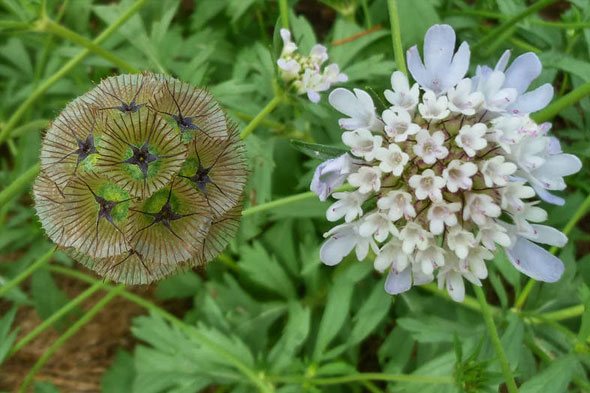

It is recommended to regularly feed with liquid fertilizers.
Important:
- Cleaning faded inflorescences contributes to the emergence of new ones.
- The addition of liquid phosphorus and potassium makes the petals more saturated in color.
What diseases are scary
Scabiosa is affected by fungal diseases and powdery mildew.
Basic rules for scabiosa care
Six easy things to know:
- Choose sunny places for planting, despite the fact that the plant is undemanding, but it will show itself in full force in open, well-lit areas.
- Around the plant, you should regularly free the soil from weeds, loosen it after watering.
- Watering should be stable and moderate, focus on drying out the topsoil.
- With the full development of the root system, you can start feeding scabiosa with liquid fertilizers.
- It is better to cut off the faded buds, this will make it possible to extend the flowering period.
- A plant transplant can be done in five years, earlier - there is no need.
Choosing a place in the garden
Grows well in an open, sunny place out of the reach of the wind. Feels comfortable on soils containing lime and various nutrients, needs a drained soil. Pebbles, sand or special stones are used for soil drainage.
Looks great in the middle of a flower bed.
Combines with all ornamental plants. You need to choose neighbors for her by color schemes. So, the seaside lobularia will perfectly set off the inflorescences of scabiosa in white and blue shades. If you focus on the aroma, then you can plant aster, gypsophila, iris and yarrow on the flower.
Delicate and touching scabiosa - the flower of the bride
Giving preference to flowers with bright and catchy beauty, we undeservedly push the modest and inconspicuous plants into the background, and only after looking closer, we notice their charm. At first glance, scabiosa does not play a solo role either in the flower bed or in the bouquet, but it is this fragile flower with silky petals of pastel shades that gives flower compositions a unique sophistication and tenderness.
The flowers of scabiosa are decorative even with a closed core, while fully blossoming, they resemble cornflowers, and the heads of terry varieties are a bit like a carnation.
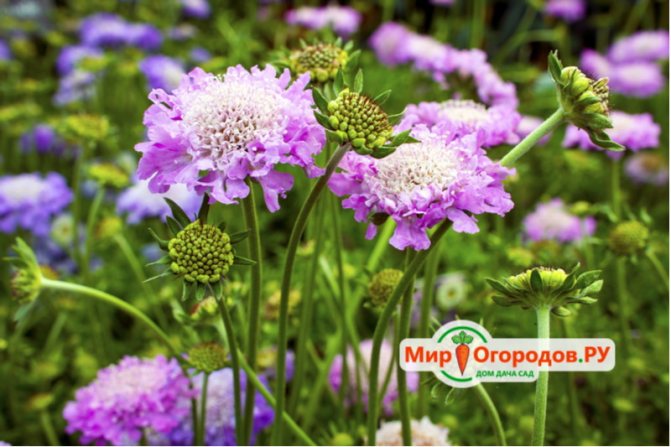

An exquisite flower full of charm and fragile beauty
Scabiosa in landscape design
Of course, scabiosa cannot be classified as an unusual exotic. This plant attracts others: its cuteness and tenderness. Its discreet beauty is more suitable for lovers of natural landscapes. However, if wild species most often do not differ in large size and bright colors, then artificially bred varieties are very noticeable in the flower bed.
The natural sophistication of scabiosa makes it indispensable for a landscape-style composition representing a piece of wild meadow. The flower can coexist with other field plants, for example, cereals, wild phlox, chamomile, cornflowers, being part of a colorful herb.
Scabiosa, especially varietal, is also good for stricter flower beds: mixborders, rabatok.Due to its small size, the flower is best suited for medium and long-range scenes. A group of several plants, forming a dense curtain, will look most impressive. In this case, you can pick up both the same and differently colored varieties.
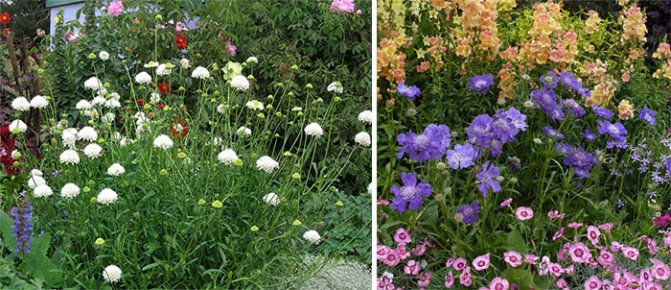

Low views can be used to decorate an alpine hill or any other flower beds with stones.
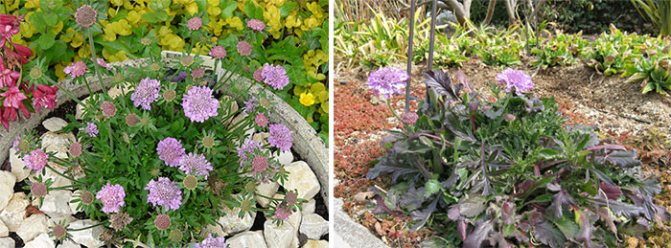

When choosing partners in a flower arrangement, one should take into account the size of the plants, the color of their inflorescences, as well as the flowering time. Perennial representatives of the Aster family (pyrethrum, coreopsis, Gaillardia) will look great in a high flower bed next to scabiosa, especially since their yellow and red flowers will make a beautiful contrast with blue and lilac inflorescences. If an ensemble of different heights is planned, low ground covers can be planted in the foreground: Armeria, Kermek, Iberis.
Scabiosa is good not only in flower beds, but also in bouquets. It stands well in the cut, keeping freshness for a long time.
Modest and charming meadow flower
Scabiosa is an extensive genus of the Vorsyankovye family, numbering about 100 species of perennial, biennial and annual herbaceous plants. The main habitat is the steppe zone, floodplain and subalpine meadows of Eurasia, South African prairies. Many representatives of scabios are relics of the Tertiary period, for example, the protected species C. pigeon, sivets.
In perennial plants, the rhizome is thick and short, ending in thin roots. Cirro-dissected leaves are collected in a basal rosette, from the center of which one or more shoots emerge, forming flower buds at the end. The height of the stems, depending on the species, varies in the range of 30–100 cm.
The inflorescence is very interesting. The round head with tubular flowers is surrounded by large wavy petals, reaching a diameter of 10 cm. The bud opens in two stages - first the outer corolla, then the core. The color palette of scabiosa is diverse - natural species are characterized by light blue, pale yellow, cream, light purple color, decorative annual varieties are distinguished by rich shades - purple, intense blue, violet.
Advice! When determining which flowers can be used to plant scabiosa in a flower bed, choose early flowering peonies, irises, deciduous ornamental hosts, begonias as neighbors. Modest asters, chamomiles, anaphalis, bright salvias, evening primrose, monarda are suitable as partners.
Scabiosa flowers with a description and photos of plants
If you read the botanical description, scabiosa flowers have small flowers of a soft lavender, blue, lilac or light cream shade in the form of a single head, which is located on the stem.
The flower is rich in nectar, which is why it often attracts various insects, including butterflies. Some varieties of scabiosa are used as food for some lepidoptera larvae.
The following are photos of the scabiosa plant, which illustrate the richness of shades and the variety of petal shapes:
When grown in a garden, this plant can be cultivated as a perennial crop. But most often the seedling method is used, which guarantees the purity of varietal characteristics and excellent abundant flowering over a long period of time. How to implement all this - we will tell further.
Family ties
Despite extensive family ties throughout the planet, only a few of the most interesting and decorative species of scabios have been introduced into the culture. It was they who gave the genetic material for breeding garden forms of culture.
- Caucasian scabiosa is a textbook representative of the genus, which has long and firmly established itself in our gardens. This is a classic perennial 50-60 cm high. It forms a lush bush, at the peak of flowering simultaneously dissolving up to 30 white, cream, light ocher flowers - it is not a shame to plant such a flower bed! It served as the basis for numerous varieties and hybrids with an intense blue, violet, purple color.A distinctive feature is a long, over 40 days, flowering period.
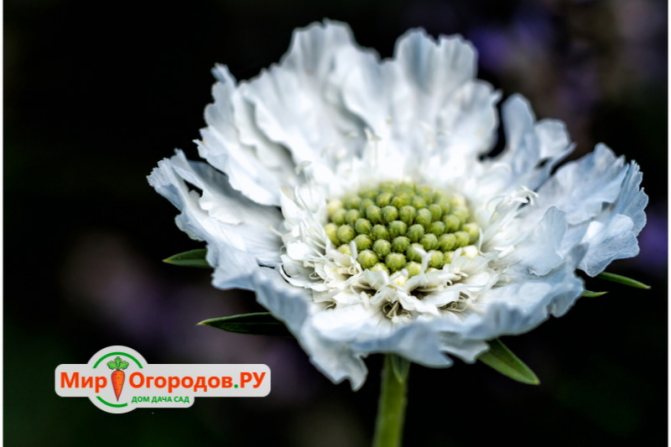

Perennial Caucasian scabiosa bush in bloom - Japanese scabiosa is a perennial native to the islands of the Japanese archipelago. It is a cold-resistant crop that grows on sunny mountain slopes and meadows. In gardens, it is more often cultivated as a biennial plant. Forms a tall (up to 90 cm), low-branched bush. Inflorescences are small, rounded-convex with protruding stamens, similar to pinheads. Garden forms are distinguished by a variety of colors.
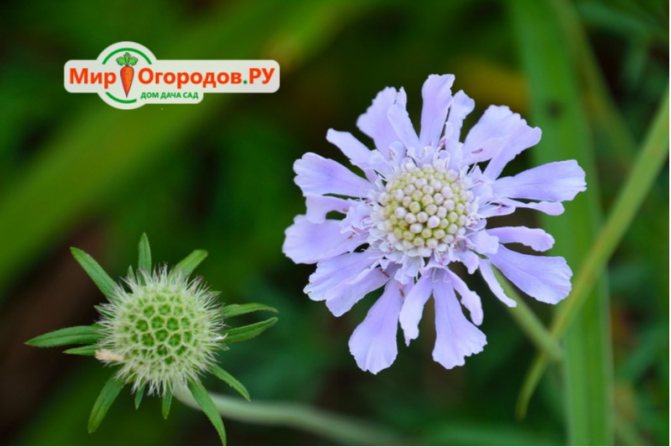

Japanese look with flowers similar to pins and needles - Scabiosa purple is grown as a biennial or annual plant - planted in early spring, it will bloom in the same year, in early summer - for the next season. The species is represented by a large number of varieties and hybrids, among which there are tall (up to 1 m), bushy (50-60 cm) and undersized (25-30 cm) groups, with ordinary and double inflorescences. The color palette is varied - from pale pink and bluish to crimson and dark purple.
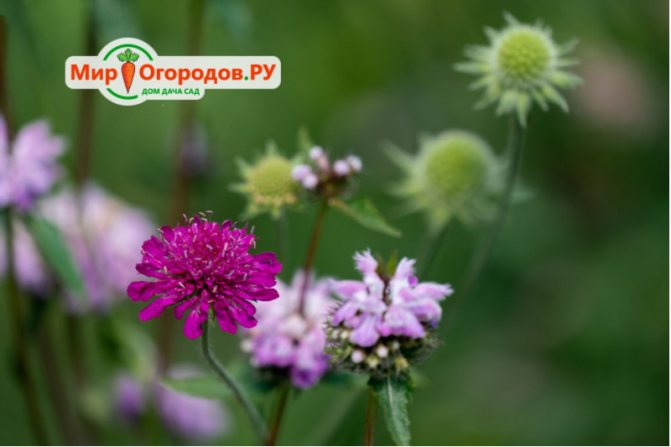

Terry inflorescences of purple colors are spectacular in the "bouquet" flower garden - Scabiosa pale yellow is one of the most unpretentious and cold-resistant natural species. The bush is almost one meter high and is covered with numerous heads of a very delicate yellowish hue. The summer flower has a long flowering until mid-autumn and a pleasant aroma. Suitable as a backdrop ornamental crop for bright, showy flowers.
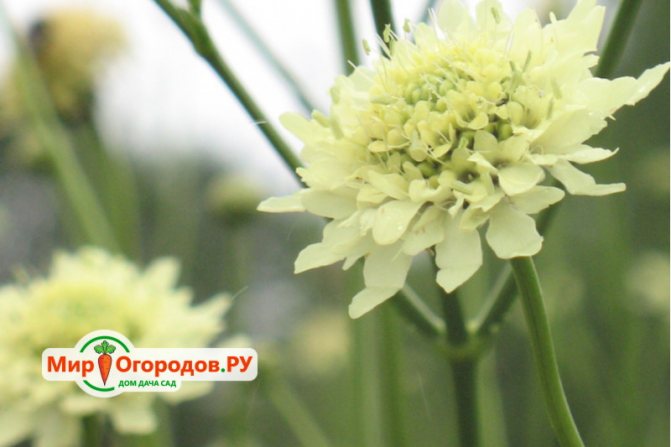

Scabiosa is pale yellow in nature - Pigeon scabiosa is a European relict species found in floodplain meadows, mountain slopes, along river banks. A perennial plant that is more often cultivated as a biennial. The flower heads on long stems are not very large, but of an interesting red-violet color, they bloom gradually - from the edges to the middle. The flowering period is 1.5 months from mid-July.
Description
This charming flower belongs to the genus herbaceous or shrubby. She belongs to the Vorsyankov family. The area of its initial distribution is the vastness of Africa. But thanks to its beauty and unpretentiousness, they began to grow it in many regions. It is also capable of growing and blooming luxuriantly even in colder climates - for example, in areas of central Russia.
Scabiosa is grown both for use in floristry and for planting in a garden or flower bed. Also, some hobbyists grow it in pots. Despite the fact that this plant is a perennial, many gardeners cultivate it as an annual, propagating annually. This allows experienced craftsmen to maintain abundant flowering and flower size.
Scabiosa bush grows up to 1 m in height, consists of erect stems. The bush is quite sprawling, which is achieved by large branching. The leaves are pinnate. Flowers are inflorescences that are collected in dense bunches. Inflorescences are rounded, located on the stem. The color range is lilac, purple, white, cream, blue, pink, lavender.
There are more than 100 varieties of this plant, taken from nature or, for the most part, bred by the efforts of breeders.
Garden forms and varieties
On the basis of natural species of scabiosa, numerous varieties have been bred with improved characteristics - larger inflorescences, intense color, long flowering. The most fruitful was the work of breeders with the following species.
- Highly decorative varieties of blue-violet shades - Blauer Atlas, Clive Grieves, Morheim Blue, Nachtfalter - originated from Caucasian scabiosa. Vivid representatives of this group of scabios are the varieties Miss Wilmotg and Alba with large white flowers.
- On the basis of Japanese scabiosa, wonderful border perennials of the varieties Ritz, Romance, Blue Diamond have been bred.
- Scabiosa purple has numerous varieties - varieties are distinguished by a rich color and large double inflorescences.Douglas, Dessert, Scarlet, Blue Mon, Rose Cascade varieties are popular with gardeners.
- Pigeon scabiosa in culture is represented by the popular Pink Mist variety, which, due to its low compact bush, is widely in demand as a perennial border plant.
It is interesting! Florists love to include delicate touching flowers in wedding bouquets. Especially popular is the stellate scabiosa (stellata), varieties with delicate lilac, cream and white flowers.
Scabiosa Caucasian, Japanese and Yellow
Caucasian scabiosa is one of the species of flowering plants in the family native to the Caucasus, northeastern Turkey and northern Iran. It grows up to 60 centimeters long. On erect stems, it bears buds with open blue or pale lavender flowers up to 8 centimeters in diameter. This species blooms from late summer to autumn. The bush attracts a variety of insects, including bees, which help pollinate it.
Japanese scabiosa is native to Japan - the island of Honshu, Shikoku and Kyushu. There you can meet her both in meadows and on mountain slopes up to two thousand meters high. Seeds for seedlings should be planted in mid-March, and in open ground in early May. The variety has a high level of cold resistance. Like other species, Japanese scabiosa does not tolerate wet soils, so you need to take care of drainage. Red and pink shades of petals prevail, and the leaves are slightly pubescent. In Japan, flower leaves are considered edible, so they are often eaten along with the roots (but only after heat treatment).
Scabiosa has yellow and creamy yellow flowers. In nature, it is found in Europe and Western Asia. The care and fit characteristics are similar to the main view.
Scabiosa, the peculiarities of planting and caring for which will be discussed in this article, is a special plant that requires an individual approach to cultivation. In this regard, there is a need for a competent organization of the irrigation, fertilization, lighting, reproduction and implementation of c.
What can give even more joy, warmth and light, if not original handmade flower arrangements? In this material, perennial crops of scabiosa, belonging to the genus and species of shrubby herbaceous plants, will be considered. To contain such interesting beauty as scabiosa, planting and grooming is the first thing to become familiar with. Consider traditional revered varieties and a few photos to get an idea of what to face.
Growing scabiosa in the garden
Scabiosa is one of the most unpretentious, cold and drought-resistant garden plants of the flowering group, so its cultivation is not a problem even for beginners in ornamental floriculture.
Location
Perhaps the only adamant requirement that scabiosa has is a sunny place for planting, preferably on a hill, so that there is no flooding or the proximity of groundwater. Like most garden plants, it loves loose, fertile soil, but it will not wither on scanty soil, unless the flowers are not so large and bright.
Planting an annual crop
Annual scabiosa is most often bred by growing from seeds by sowing in open ground. They do this at the same time as other annuals, approximately at the end of April - beginning of May. If you are confident in the germination of seeds, they can be sown immediately at a distance of 25-30 cm, but experienced florists recommend sowing denser, and then breaking through or planting. It takes about three months for the plant to germinate, build up green mass, and distill the peduncles, so with this method of planting, flowering will begin somewhere in the second half of July and will last until mid-autumn.
To bring flowering closer, they practice the cultivation of scabiosa for seedlings. Sowing in this case is carried out indoors in March.In a container with light and moist soil, consisting of peat, turf and sand (perlite, vermiculite), seeds are sown to a depth of no more than 0.5 cm, covered with a plastic lid (glass, polyethylene). The container is in the closed position until the seeds are pecked; it is only occasionally necessary to open it for ventilation. When 2 true leaves appear at the seedlings, the seedlings dive into individual containers, in which they will be located before disembarkation.
Perennials
Perennial scabiosa is also grown by seeds, through seedlings, but the vegetative method is also used - by dividing the bush. When propagated by seeds, the culture will bloom only in the second year, if you grow good strong seedlings, you can achieve flowering already in the current season.
In early spring, a perennial bush can be divided into parts so that each fragment contains a piece of rhizome and at least three buds. Delenki are planted in a permanent place at a distance of 25-30 cm.
Scabiosa after planting in one place can grow up to 5 years and requires virtually no maintenance. Watering is needed only in dry weather, and then not on purpose, but for the company with other flowers.
Experts recommend feeding the plantings with phosphorus-potassium or complex fertilizers during the budding period - this will make the flowers larger and brighter.
In cold regions, the wintering rhizome of the culture is covered with fallen leaves, straw, in order to protect it from freezing.
Growing and care
In the wild, scabiosa most often grows in dry, warm places: in meadows, forest edges, mountain slopes. Ornamental varieties prefer similar conditions. We can say that this culture is suitable, first of all, for owners of open sunny areas.
Location, soil
For disembarking scabiosa, you should choose well-lit places. The plant perfectly tolerates direct sunlight without fear of burns. As a last resort, you can place the flower in partial shade.
[!] In the shade of scabiosa it will stretch out, and flowering will be poor or not at all.
You should not plant a perennial in a lowland, especially where melt spring water accumulates. This southern culture does not like locking, reacting to excess moisture by rotting roots.
The composition of the soil is not as important as good lighting, however, if you want the flower to grow vigorously and develop correctly, use a loose (water and air permeable), highly nutritious substrate with a neutral or low alkaline reaction (pH 6.6 -7.5) ... Too fat heavy soil should be slightly diluted with sand, and poor soil, on the contrary, should be enriched with humus.
Watering, feeding
How to water scabiosa depends solely on the weather. If the summer is rainy, watering can be completely eliminated; on hot sunny days, a little extra moisture will not hurt. In general, this flower cannot be attributed to overly moisture-loving crops, so watering should be very moderate.
As for feeding, it is possible to recommend fertilizer for flowering flowers with an increased amount of phosphorus and potassium, which are introduced during the period of budding and flowering.
Pruning and shaping, wintering
Some gardeners complain about the instability of scabiosa. Indeed, tall varieties sometimes lull from strong winds or rain. A metal or wood stopper can be dug in to support the plant. Medium-sized and undersized species do not need support.
To preserve the decorative appearance, wilted peduncles should be removed. Another undoubted plus of this procedure is the appearance of new buds instead of cut ones.
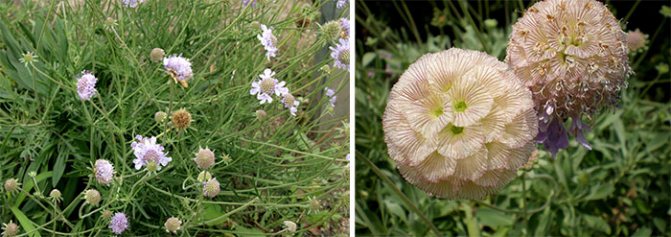

In central Russia, scabiosa hibernates without shelter. In more northern regions, the flower, especially its southern species, is recommended to be protected from frost by sprinkling the root with fallen leaves, branches or spruce branches.
Reproduction and planting
In nature, scabiosa most often reproduces by self-seeding. In culture, a plant can also be obtained from seeds, and perennial species can also be obtained by cuttings or dividing a bush. Let's consider all these methods in more detail.
Seed reproduction
Seeds are planted:
- early spring for seedlings,
- at the end of May in open ground,
- in October in open ground.
The timing of planting seeds depends on several factors. Fresh seeds can be sown in spring, it is better to sow a little lying down before winter, so that they undergo natural stratification (hardening). In addition, one-year scabiosa from seedlings blooms earlier. On a perennial, buds appear only in the second or third year.
The sowing technology is quite simple:
- Soak the seeds for a day in a wet piece of cloth.
- We prepare a light nutritious soil and fill it with previously dug beds or a container for seedlings. We moisturize it thoroughly.
- Practically without deepening, we add seeds.
After 2-3 weeks, the first shoots will appear, which, if necessary, need to be thinned out. If scabiosa is grown in seedling boxes, then it can be transferred to open ground not earlier than the end of May, after the threat of night frosts has passed. Seedlings are planted according to the 30x30 cm scheme so that later adult plants do not interfere with each other.
Scabiosa - pin pads: growing, grooming, scabiosa varieties
Scabiosa is a flowering, unpretentious, perennial flowers grown in our gardens as annuals. The long bloom of scabiosa and the delicate aroma attract the bees to the flowers, which collect nectar and process it into honey.
In landscape design, three types of scabiosa are most common: Caucasian scabiosa (violet-blue-blue flowers), purple scabiosa (burgundy-pink-red flowers) and Japanese scabiosa.
Agrotechnology of all types and varieties of scabiosa is simple to the limit - it is enough to plant seeds or seedlings in fertile soil in a sunny, sheltered from the wind place and periodically water to enjoy the bloom of scabiosa in June-July, for a month.
Decorative qualities
Scabiosa is used in landscape design due to its high decorative qualities. It is combined with phlox, cornflower, asters, irises, yarrow and other bushy or paniculate plants. The decorative effect is achieved due to the contrast of color shades and texture of flowers.
Scabiosa in landscape design is widely used in the creation of rockeries, alpine slides, mixborders. Dwarf and undersized species of scabiosa will perfectly decorate the borders along the garden paths.
In floristry, the scabiosa flower has also found wide application - it is used to create not only field bouquets, but also any other festive compositions, not excluding wedding bouquets. She achieved such popularity thanks to unusual bright inflorescences.
Types and varieties of scabiosa
Scabiosa was first described by the Austrian scientist Belsazar de la Motte Hacquet in the 18th century. Since then, a lot of water has flowed under the bridge: new types of scabiosa were discovered, as well as garden varieties that never occur in nature.
Caucasian scabiosa
Blue flowers with a lilac shade of Caucasian scabiosa (Latin Scabiosa caucasica) are collected in a capitate inflorescence up to 10 cm in diameter. Blossoms in June-July during. Fragrant flowers are dome-shaped with stamens, which outwardly resemble small pads for pins.
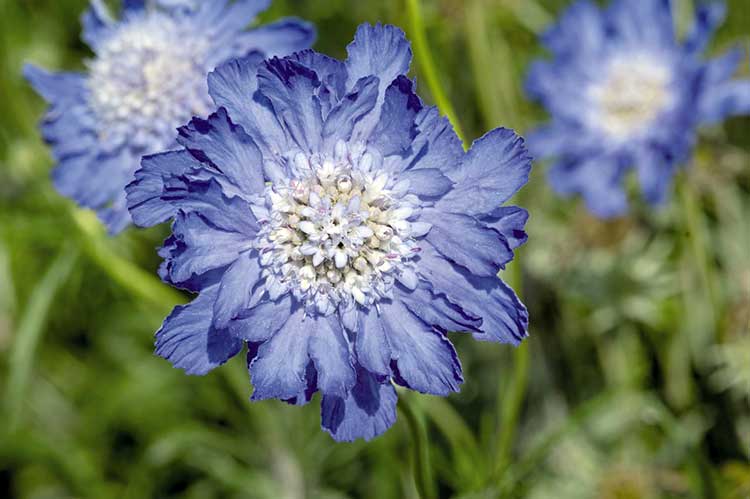

Caucasian scabiosa (Scabiosa caucasica). Photo: Center jardin Brossard
Caucasian scabiosa is used to create spectacular borders, to form the transition from tall plants to undersized ones, filling the foreground. Scabiosa works best in groups of three or more plants. Scabiosa can be planted along hedges growing in the sun.
Low-growing scabiosa varieties are good in rocky gardens. In pots, Caucasian scabiosa can be combined with other species, for example, plant lobularia or lobelia along the edges.
Scabiosa is planted singly or in groups in mixborders and ridges, near shrubs. It goes well with asters, irises, hosta, and dwarf scabiosa is an ideal flower for growing along sidewalks.
Caucasian scabiosa can be grown for cutting - cut flowers are stored in water for 7 days.
There are varieties of Caucasian scabiosa with white, pink and dark purple flowers. Scabiosa inflorescences attract butterflies, which, with the help of long proboscis, drink delicious and nutritious nectar from them.
Caucasian scabiosa has very decorative hybrid forms, differing in the height of the bush and the color of the inflorescences:
- Blauer Atlas - blue-violet flowers;
- Clive Greaves - large-flowered inflorescences, bluish, on high stems;
- Clive Grieves - flowers are light purple, inflorescences are very large;
- Miss Wilmotg - inflorescences are large, flowers are pure white;
- Morheim Blue - inflorescences are deep purple;
- Nachtfalter - flowers are intense blue.
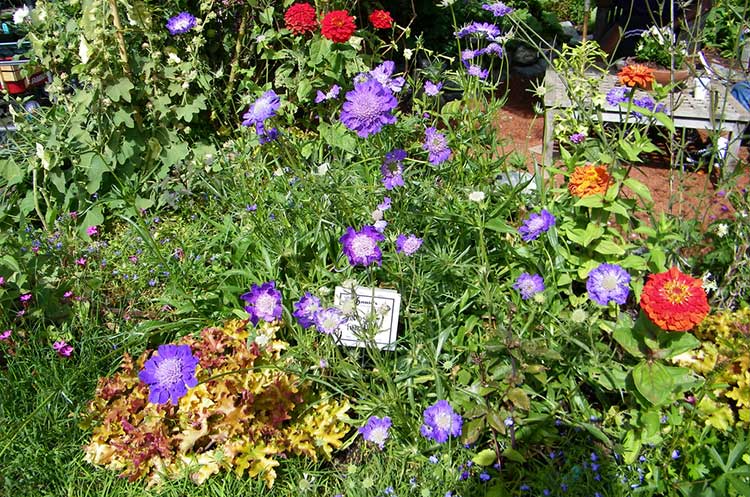

Scabiosa Caucasian, Fama Blue variety in garden design. Photo: xaviergardens /
Caucasian scabiosa loves to grow in well-lit, sun-protected areas of the garden. In a windy place, the flowers will wilt.
The soil for this type of scabiosa should be light, loose, well-drained, fertile. Before planting Caucasian scabiosa, organic fertilizers are applied to the soil per 1 m 2 and processed to the depth of a shovel bayonet.
Caucasian scabiosus is fed with phosphorus-potassium fertilizers, increasing the brightness of the color of flowers. Mineral fertilizers must be applied during the formation of buds.
When caring for Caucasian scabiosa, you should know that the plant does not like waterlogging - it is better not to water than to pour... In the dry season, water should be done more often so that flowering does not stop.
To preserve the decorative appearance of the flower bed, it is necessary to regularly cut off the withering inflorescences of scabiosa so that new flowers form on the plant. In autumn, the stems of Caucasian scabiosa are cut at a height of 10 cm from the ground.
Caucasian scabiosa can hibernate without shelter, but in a winter with little snow, cold, winter without insulation will freeze. Before severe frosts, scabiosa should be mulched with light material: fallen leaves or straw. Compost is not suitable for mulching due to the large amount of moisture.
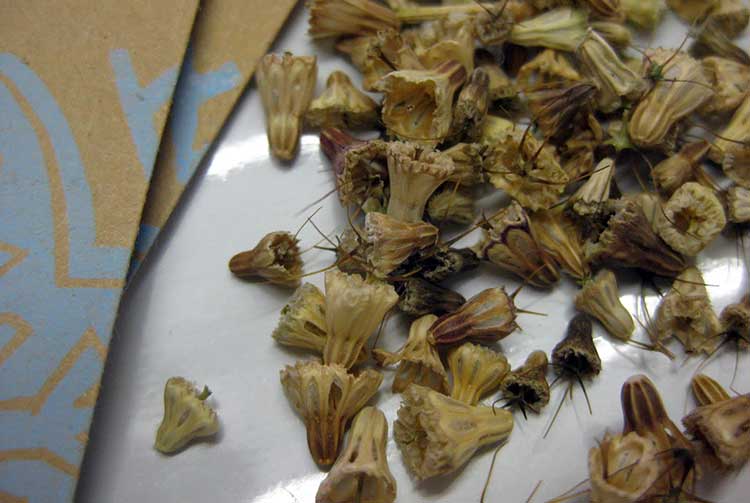

Scabiosa seeds. Photo: BareBlooms
Caucasian scabiosa is propagated seeds and vegetatively - by root cuttings or by dividing the bush. Seeds are sown in autumn, in March in a greenhouse or in May in open ground. Seedlings appear in days after sowing. Seedlings dive, planting at the beginning of June to a permanent place according to the scheme 25 × 30 cm.
When grown from seeds, scabiosa is capable of blooming in the first year.
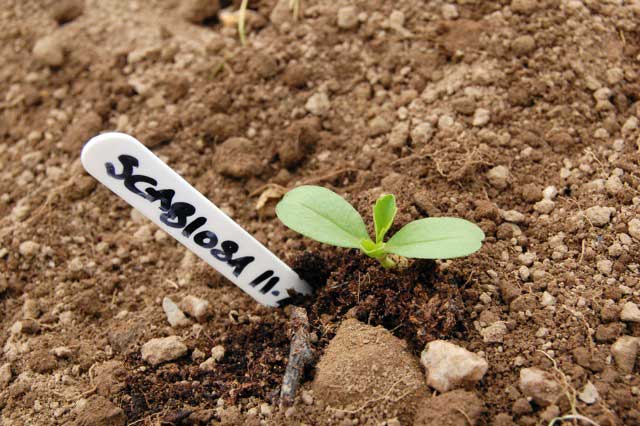

Monthly seedling of scabiosa. Photo: Higgledy Garden
In the spring, Caucasian scabiosa is propagated by division. Remove the formed groups of flowers and divide them so that there are two or three shoots with roots on the shoots. Old scabiosa scattered around the garden can be reproduced in the same way. Planting every year rejuvenates.
Scabiosa purple
Scabiosa purple (Latin Scabiosa atropurpurea) is a branchy plant on sinewy legs with vertical leaves with jagged edges. They can be up to five centimeters long.
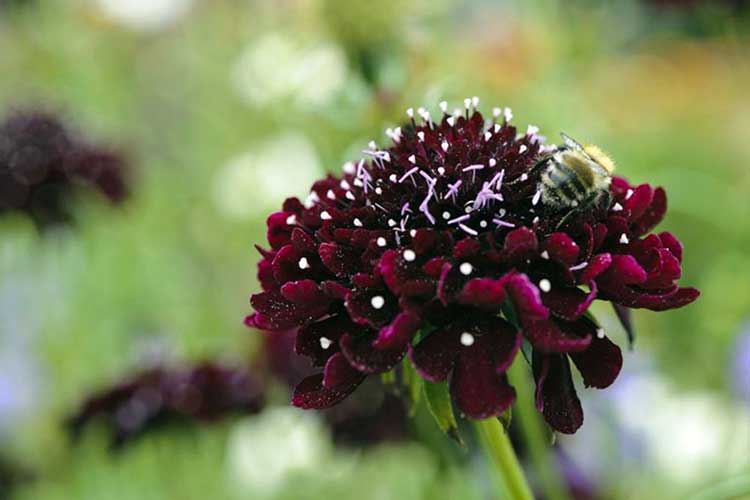

Scabiosa purple (Scabiosa atropurpurea), Black Knight cultivar. Scabiosa is a good honey plant. Photo: Gardeners World
Scabiosa purple flowers are usually red, but can be white, purple, blue. Fragrant flowers, flower diameter 2 cm.
Scabiosa dark purple grows well in a sunny place on neutral acidic and well-drained soil. Like Caucasian scabiosa, it does not like waterlogging, it grows out in winter.
Scabiosa purple varieties:
- Ace of Spades (Ace of spades) - scabiosa with burgundy flowers and light stamens;
- Chile black (Black chili) - very dark, almost black inflorescences;
- Snowmaiden (Snow Maiden) - white-flowered variety of scabiosa;
- Fata morgana (Fata Morgana) - scabiosa petals have an original, yellow-pink hue;
- Chili pepper (Chili pepper) - bright scarlet elegant inflorescences;
- Musical Prelude (Musical prelude) - white and purple mix;
- Salmon queen (Salmon Queen) - salmon-colored inflorescences.
Most popular varieties
Scabiosa purple.
A strong plant with a thick stem, stems sinewy, thick. The leaves are serrated, arranged vertically, up to 5 cm long. The flowers are small, up to 2 cm in diameter, with a very strong pleasant aroma. They come in white, purple, blue, or pink.
When choosing a planting site, remember that the plant loves sunny meadows, sandy loam or loamy soil with a neutral acidic environment. If the soil is heavy, then drainage is required. bushes do not tolerate excess moisture.
This variety is common in southern Europe. A distinctive feature of this variety is white flowers that dazzle in inflorescences of a different color. It is an annual plant, but there are several perennial varieties. Loves organic soils. Accepts well soils, the temperature of which is never below zero. Good for increasing the alkalinity of the soil by adding lime.
Caucasian scabiosa.
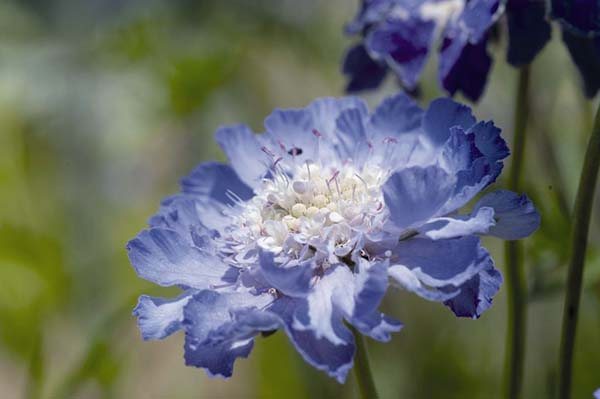

Caucasian Scabiosa / Scabiosa caucasia
The native land of this species is the Caucasus Mountains, Turkey and Iran. It has bushes with erect stems up to 60 cm high. The flowering period of this species is the second half of summer and autumn. Inflorescences are large, up to 7-8 cm in diameter, blue or lavender in color. Loves well-drained soil.
Japanese scabiosa.
Her homeland is the Japanese Islands, where she grows both in the mountains and in the valleys. It can be found up to an altitude of 2000 m. The variety is very frost-resistant, therefore it is suitable for planting in mid-latitudes. Seeds for growing seedlings need to be sown in mid-March, and you can plant them in the ground already in early May. Japanese scabiosa will grow well on drained, sandy loam or loamy soils. It does not tolerate stagnant water and excessive moisture. Inflorescences are red or pink, leaves are fleecy.
Terry scabiosa.
The plant has gorgeous large inflorescences with double flowers. Flowers of very different colors, depending on the variety - white, red, burgundy, light blue, blue, dark shades of lilac and purple, pinkish, scarlet, lavender. A list of some terry varieties: Cherry, Lavender Lady, Duenna, Fruit Ice, Crystal.
When scabiosa blooms
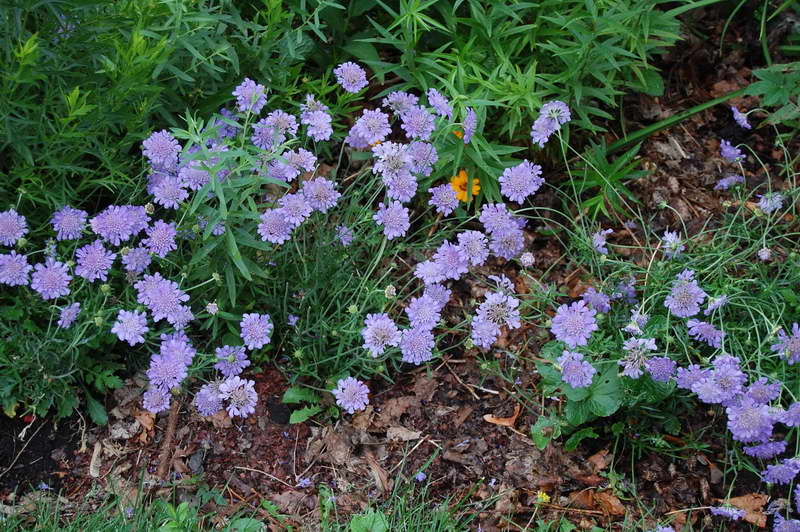

What scabiosa looks like In the photo, the variety Butterfly blue
The flowering period of scabiosa begins in July and lasts until the end of September.
The calyx is double: the outer part consists of 8 ribs, the margin is dry, the inner one is saucer-shaped, five-membered, long stamens with anthers effectively decorate the core. The colors can be blue, snow-white, blue, pink, pale yellow, bright crimson, dark purple. The flowers are fragrant, attract bees with their nectar, colorful butterflies flutter above them. At the end of flowering, the achene fruit ripens, filled with many small seeds of a light brown hue. 1 g of weight contains about 350 seeds.
In the natural environment, scabiosa can be found on the territory of the Old World, prefers limestone areas.
How to properly plant scabiosa
Scabiosa, the cultivation of which in the open field requires the attention of a grower no more than other flowers, is a rather light plant in culture.
How to choose a place, time and soil
The main thing is to opt for a sunny area, where there is no shade for most of the day.
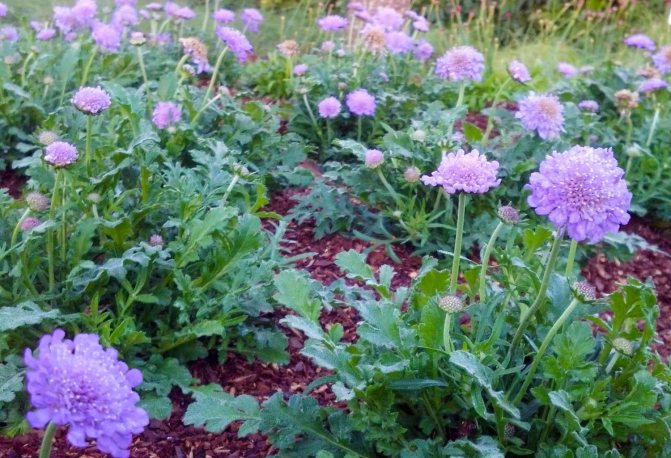

The soil at the site of planting for scabiosa needs fertile and light, well fertilized with humus.
It is better that the groundwater does not come close to the surface. Many species, especially Caucasian scabiosa, are intolerant of wet soils.
Therefore, it is advisable to plant representatives of the genus on small elevations of the relief, to avoid hollows.
Low forms and varieties of plants are perfect for planting on an alpine slide.
On a flower bed, seeds are sown depending on the climate of the location in early May, in more southern regions they are sown in the last decade of April.
Seed planting technology in open ground
Freshly harvested seeds are sown in October. They undergo natural stratification in the ground under the snow.
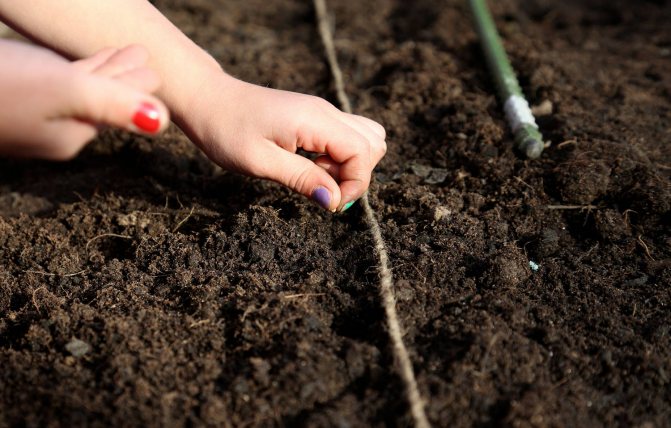

For spring sowing, the seeds must be kept in the refrigerator for 2-3 months in the vegetable compartment. Before planting, it is advisable to soak in warm water for a day for better germination.
In the garden, they sow in shallow grooves, covering no more than 1.5 cm. Seedlings in different species appear after a different period of time.
For example, dark purple scabiosa and its varieties emerge before everyone else - a week or one and a half after sowing, then stellate sprouts appear in 2-2.5 weeks, and the Caucasian sprouts the longest - 3-3.5 weeks.
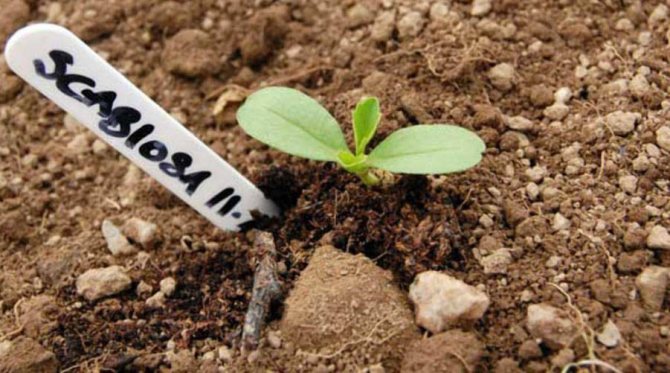

When 2-3 true leaves are formed in seedlings, they are thinned out or dived to a permanent place of growth, placing them at a distance of 20-30 cm from each other.
When planted in open ground, scabiosa from seeds blooms in the second year, and perennials can form flowering stems for the first time in the 3rd year.
Autumn care, seed collection and wintering
Annual species of scabiosa are dug up and thrown away in the fall. If necessary, seeds are collected at the end of summer. Choose suitable inflorescences, tie them with gauze so that there is no self-seeding. When the seed pods are completely dry, they are cut off. Seeds are poured out of boxes, stored in paper bags in a dry place.
Perennials are left to winter on the site. After the end of flowering and drying of the leaves, the stems are cut to the level of the soil. Scabiosa can be left without shelter. But hybrid varieties can freeze. Therefore, for the winter they are spud with dry foliage or straw. In the spring, the shelter is removed.
Correct planting of the plant
On the backyard and summer cottages, lush buds become a magnificent decoration of the landscape, provided that the site is correctly selected and the planting work is carried out, followed by regular care.
Planting period
Scabiosa is grown from seeds. They can be planted directly in prepared flower beds in the open field. This technique is practiced throughout April in the absence of severe night frosts. When waiting for a late cold spring, they should be sown in special containers for seedlings no later than mid-March.
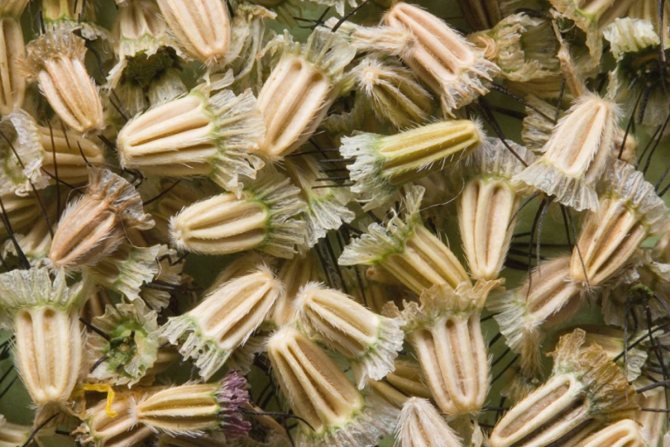

Photo: <>
Location on the site
For effective breeding of scabiosa, a sunny place should be selected. To ensure long-term flowering, the wind rose is taken into account, creating protection from the strong prevailing wind. The site should be elevated, without the close location of aquifers, since the flower does not develop well with prolonged waterlogging of the soil.
The soil
Annual species of scabiosa are able to successfully adapt to different types of soil. But, when planning the cultivation of perennials, you should carefully consider this issue. To ensure good subsequent growth and annual abundant flowering, loose soil with high fertility rates with a neutral reaction is selected.
For scabiosa placement, areas with high soil acidity are avoided. In such conditions, the plant develops poorly, dries up and gradually dies.
Good neighbors in the flower bed
When creating a sketch of a flower garden on which scabiosa will be placed, it must be borne in mind that irises, begonias and chamomile are the most suitable neighbors for it. Peonies, asters, monarda, gypsophila paniculata and anaphalis get along well next to this decorative culture. Phlox paniculata, large-flowered daisy, deciduous ornamental hosts, catchy salvias will not feel oppressed. An excellent solution is an ensemble of scabiosa with ground cover ornamental plants - Iberis, Armeria. It is not recommended to plant flower crops in the same flowerbed with scabiosa that require highly moist soil, for example, arysema, marsh calla, buzulnik, loosestrife. Trillium, bulbous calypso and helmeted orchis will not get along in the neighborhood.
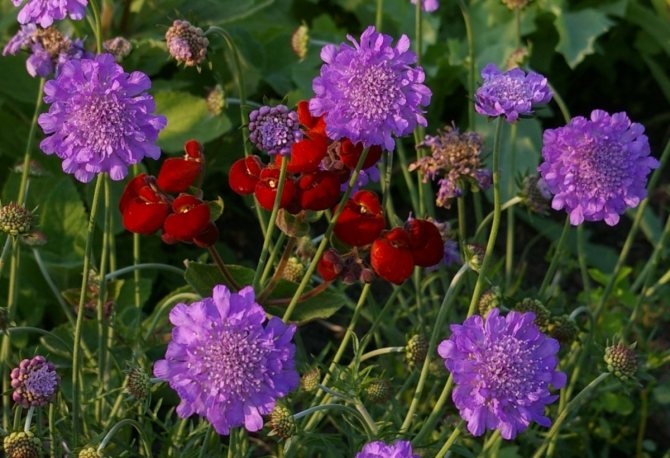

Photo: <2.bp.
Scabiosa: Combination with other plants
Fantastic flowering of various varieties of scabios will not leave anyone indifferent. If you correctly combine them with other types of herbaceous perennials in pastel shades, then the result is a flower bed of incredible beauty. Such flower combinations will decorate with their presence the most original exteriors and bring the most extraordinary ideas of landscape design into reality.
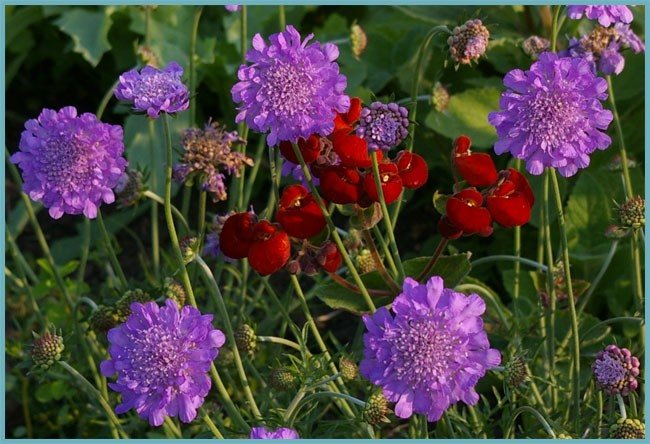

Scabiosa in a flower garden
For example, scabiosa in blue and white shades make a stunning combination with white seaside lobularia. The purple Caucasian scabiosa can be combined well with various plants of the rural garden (paniculate phlox, Fassen's catnip, large-flowered daisy, etc.). You can use fragrant combinations of scabiosa with paniculata gypsophila, asters, irises or yellow yarrow.
Scabiosa is also used to create beautiful festive bouquets, vivid examples of which you can see in the photo.
Scabiosa in floristry
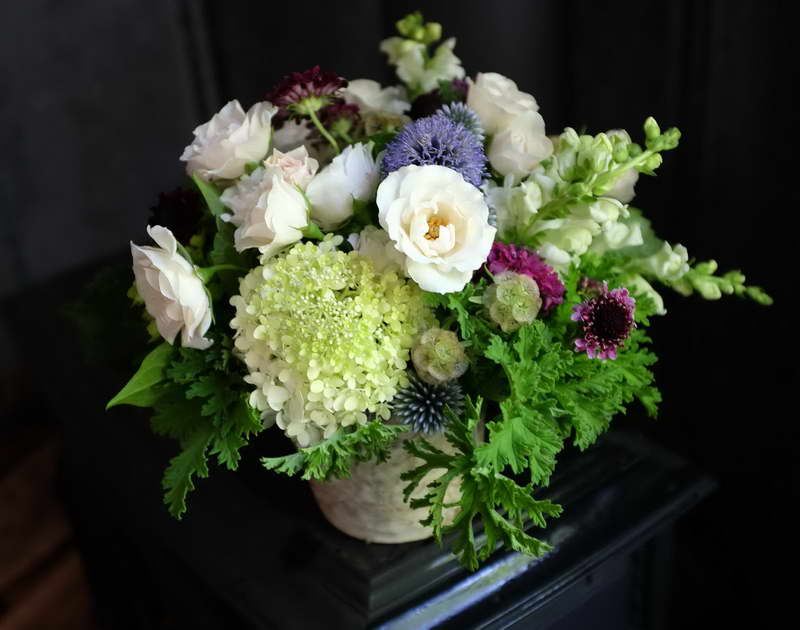

Scabiosa in a bouquet photo of flowers
Also, scabiosa inflorescences are used to create incredibly beautiful, festive bouquets. After cutting, they retain their decorative effect for 5-7 days.
In addition, scabiosa flowers are used as dried flowers, which are a very original interior decoration.
Read also Orni farm respivet for pigeons
Scabiosa: planting and caring for a plant
Nothing grabs your attention and the gaze of your neighbors like the fabulous Scabiosa culture. Planting and grooming outdoors is a trivial task even for the average user, since it doesn't take much effort. An open sunny area will be enough for growth, and the soil should be selected as carefully as possible so that there are no difficulties with the launch of roots and the subsequent flowering of the variety. As the best option, venerable gardeners recommend choosing lime soil, which contains a large amount of nutrients.
It's important to know!
The plant has colossal risks of death if it is planted in an overly acidic environment.
Features of fertilization and top dressing of the soil
The cultivation process must necessarily be accompanied by various kinds of dressings. This is usually done at a time when the full development of the root system has occurred. Traditionally, gardeners use liquid fertilizers that are soluble in drinking liquid. When feeding, the proportion must be observed: 20 g of fertilizer per square meter of land. A distinctive feature of these plants is an instant reaction to the applied top dressing, therefore, the necessary proportions must always be observed.
Phosphorus-potassium fertilizers are traditionally chosen, which contributes to an increase in the size of the buds and rich flowering. So, perennial scabiosa, planting and caring for which are quite simple, acts as an interesting plant culture. She will definitely require some attention and effort, but in return she will present you with the opportunity to admire her throughout the warm period of the year.
Protection from pests and diseases
The flower is quite resistant to most diseases and pests. It is difficult for the plant to tolerate only excess moisture. Due to waterlogging of the soil, fungal infections (powdery mildew, root rot) can develop. If the plant begins to wilt, you need to pay attention to the moisture. At the initial stage of the disease, you can treat the bush with a sulfur agent. But if the rot is very struck by the scabiosa, then it is better to dig it up and burn it, disinfect the area.
Of the pests, the flower can be affected by aphids and garden slugs. To prevent their appearance, it is necessary to mulch the soil around the bush and treat it with a weak saline solution.
Growing conditions
Under natural conditions, scabiosa is widespread on the slopes of the mountains, its individual species are found even at an altitude of 2000 m.But it also grows well in meadows, on forest edges and wherever the soil is well-drained, it has a neutral or alkaline reaction. The composition of the soil does not play a big role. It is only important to remember that stagnant moisture and acidic soil are destructive for a plant.
Wild scabiosa is adapted to unfavorable conditions. It easily tolerates drought and direct sunlight. It grows well in partial shade and hibernates under the snow. Ornamental plant varieties have inherited most of the listed qualities and therefore are considered very unpretentious.
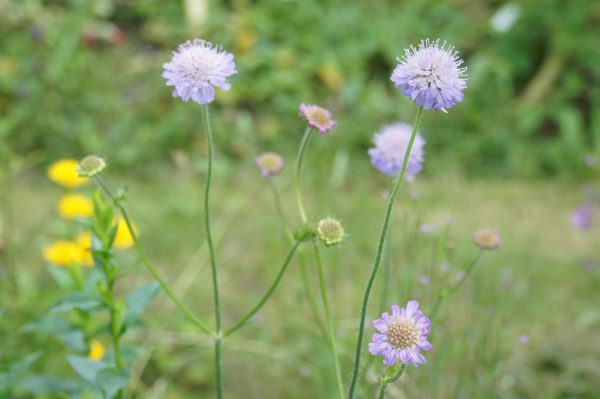

Wild growing scabiosa
ON A NOTE. In culture, scabiosa is grown in open sunny areas, possibly on hills or on southern slopes, where there is no flooding. The site must be protected from the prevailing winds, as the plant is sensitive to gusts of air.
Sowing time
Scabiosa is planted with seeds in the spring, when the earth is already slightly warmed up under the sun. The optimal time is mid-April, if the winter is not long. In the south, you can start sowing at the end of March, at about the same time as carrots and beets. You should not be afraid of frost, the seeds are not afraid of cold.
In regions with late spring, scabiosa is planted using the seedling method. In this case, seeds are sown for distillation in a greenhouse at the beginning of March or even at the end of winter. Sowing before winter is also practiced, in which case the first shoots will appear a couple of weeks earlier.
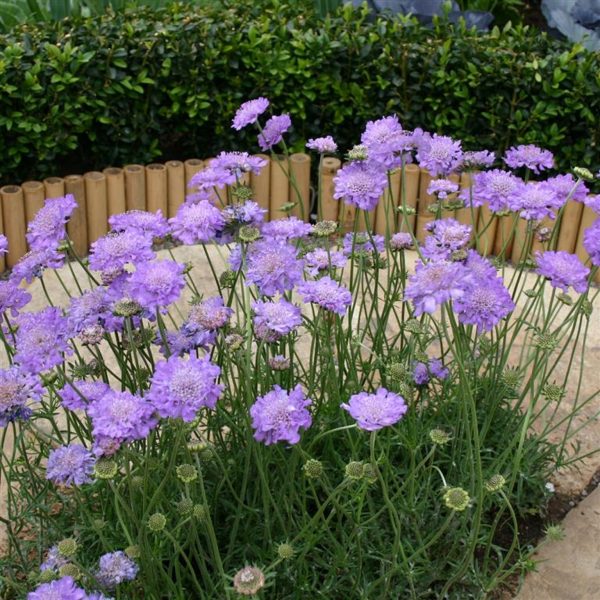

The exact sowing time is determined by the climatic characteristics of the region.
How to prepare the soil for scabiosa
Scabiosa does not tolerate heavy, clayey soils. She needs a light, nutritious substrate in which her roots will "breathe". Therefore, the sowing site is, if possible, prepared in advance, so that by the spring the organic matter introduced into the soil will quail and give up all the necessary nutrients. Together with organic fertilizers (for example, with compost), a little gravel and sand (2-3 buckets per 1m2) can be added to the soil - this will make the growth conditions closer to natural.
REFERENCE. If it is planned to sow a plant before winter, the site is dug up about 30 days before the main work.
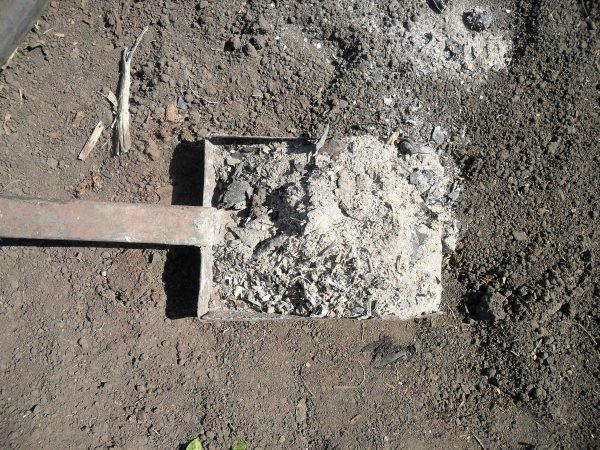

Wood ash reduces soil acidity
Since scabiosa prefers slightly alkaline soils, it will be useful to add a little wood (about 200 g / m2) or peat ash (350 g / m2) to the soil. Slaked lime or dolomite flour can be used instead of ash. From the point of view of environmental friendliness, dolomite flour is better than lime, although the effect of its use is noticeable a little later.
Slaked lime prices
slaked lime
How to prepare seed
Preparing flower seeds is not an obligatory procedure before sowing, however, a few simple tricks will significantly increase their germination and help grow healthy seedlings:
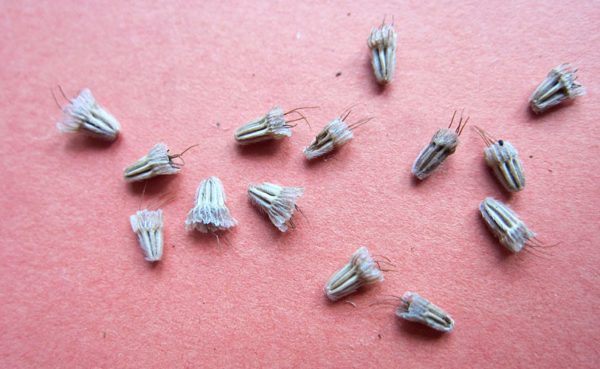

This is what scabiosa seeds look like.
Popular varieties
Each scabiosa variety has its own characteristics.
Blue Note
The height of the Blue Note variety does not exceed 19 cm. The stems are straight and branched. The flowers are dark purple in color. Abundant flowering begins in July.
Pink mist
The plant forms a bush up to 38 cm in height. Lavender or pink flowers up to 5.5 cm in diameter bloom at the end of July.
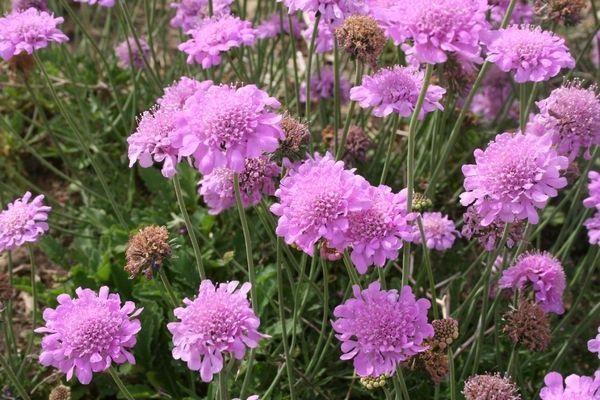

Blauer Atlas
The plant develops flowers of a deep blue-violet color in the last days of July.
Clive greaves
Stem height 58 cm. Flowers are light lavender. Their diameter in the inflorescence reaches 7.5 cm. Flowering begins in the middle of summer. Carved stem leaves.
Miss willmott
The height of the slender, strong stem is 87 cm.Flowers of a snow-white or cream shade.
Nachtfalter
The Night Moth variety is distinguished by bright blue or violet-blue flowers up to 6 cm in diameter.
Moerheim blue
Herbaceous perennial plant stretches up to 58 cm in height. Stems are erect, branched. On the peduncles, numerous flowers with a diameter of up to 5 cm of violet-blue color are formed.
See also
Planting, growing and caring for heliotrope in the open field, varieties and speciesRead
Blue moon
A perennial plant forms inflorescences of a pale blue color. The height of the erect stem is up to 64 cm.
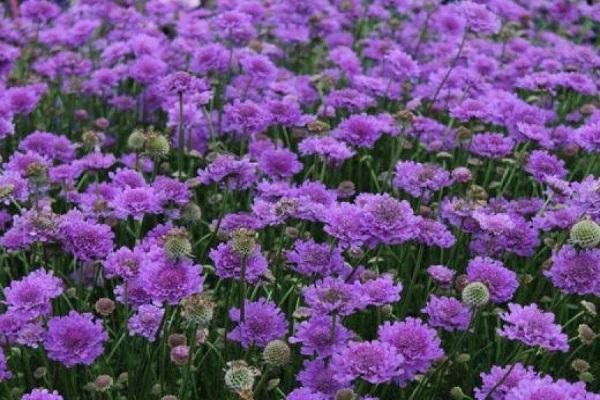

Rose cackade
The plant belongs to the dark purple variety. The inflorescences are pink in color. Flowering begins at the end of July.
Monarch cockade
The scabiosa variety is distinguished by large double inflorescences of various colors.
Fire king
The variety is distinguished by bright, large, fluffy red inflorescences with white small petals. The height of the straight, strong stem reaches 92 cm.
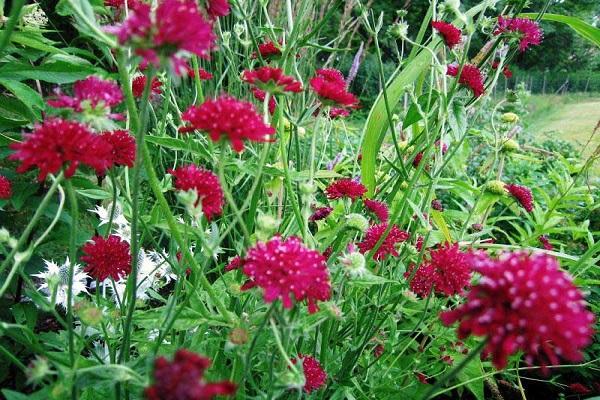

Frozen heart
This variety is characterized by abundant flowering. Stems are straight, branched, 86 cm high.The inflorescences are lush, blue-white or lavender, up to 6.5 cm in diameter.
Blauer Mond
The stem of a herbaceous plant extends to a height of 58 cm. Inflorescences are dark blue in color.
Lacherosa
The flower variety is distinguished by a compact bush 48 cm high. Inflorescences are maroon in color.
Fairy
Bushes grow small, only 24 cm. Flowers are dark blue in color.
Schneebal
The height of the stem is not more than 32 cm. The buds appear in July, the inflorescences are snow-white with a pleasant, sweet aroma.
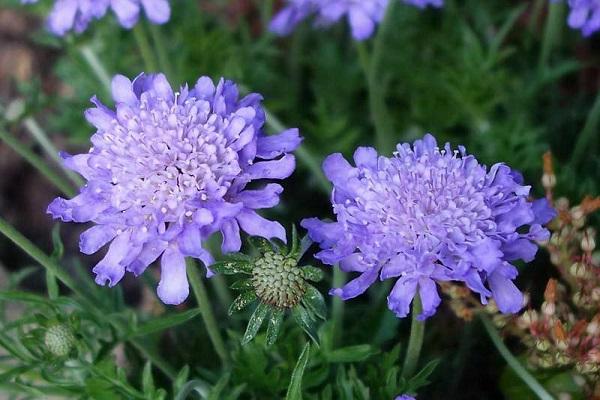

House of Isaac
The variety is distinguished by large inflorescences up to 9.5 cm in diameter, lilac-white. Flowering begins at the end of June.
Japanese romance
Flowers of this variety are distinguished by lilac-pink shades. The height of the slightly branched stem does not exceed 24 cm.
Butterfly blue
The bush is compact (up to 28 cm in diameter), low, up to 38 cm in height. Lavender-blue flowers are collected in dense capitate inflorescences. The buds begin to bloom from mid-July.
Ritz Blue
The variety is characterized by low height. The stem is straight and strong, stretches up to 22 cm. The flowers are small, violet-blue in color.
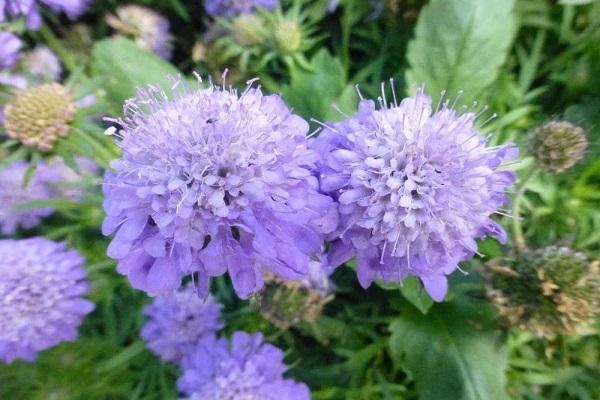

Care rules
- Watering. The plant does not need abundant watering, it should be watered mainly when the top layer of the soil is drying out.
- Top dressing. Fertilizers containing potassium and phosphorus should be used.
- Removing inflorescences... To accelerate the appearance of new buds, it is necessary to remove the faded inflorescences.
- Seed collection. Seeds are recommended to be harvested in autumn. Their germination capacity lasts for 2-3 years.
Description and features
Perennial scabiosa refers to herbaceous or shrub plants. The people call the flower pile, scrofula, rough cornflower, button:
- The stem of the flower is strong, erect or branched. It reaches a height of 1 meter.
- Leaves are oblong, in the form of feathers.
- Inflorescences are located at the very end of the stem, form dense bundles in the form of a ball or hemisphere.
- The strong aroma of scabiosa attracts pollinating insects.
- The fruit is an achene with a bell-shaped shell.
Individual parts of the plant have healing properties. Infusions and decoctions are used in the treatment of headaches or toothaches, skin rashes, and help to cope with colds.
Growing through seedlings
If the climate is cold, then seedlings are chosen. Sowing in specially prepared soil begins in March.
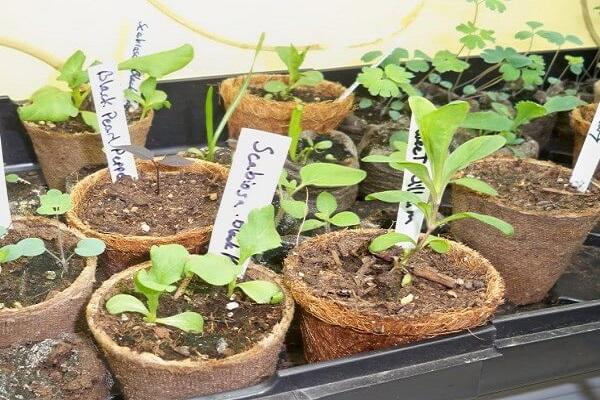

Preparation of planting material
Subject to all storage rules, seeds retain their germination for 3-4 years:
- A stratification procedure is carried out. The seeds are hardened in a humid environment. They are immersed in sand and left in the cold for about one month.
- A selection should be made before planting. For this, a saline solution is used, in which the seeds are immersed. After 15 minutes, bad, unfit for sowing specimens should emerge to the surface.They need to be thrown away.
- Then the seeds are washed and laid out on a paper napkin.
- As soon as the planting material dries, it should be immersed in a weak solution of potassium permanganate in order to disinfect the surface.
- Many gardeners soak seeds in fungicides to protect the plant from fungal and bacterial infections. Suitable drugs such as "Fitosporin" or "Baktofit".
How to plant
You can sow seeds in large boxes or individual pots. Small depressions are made in the soil, the seeds are distributed and sprinkled on top with a layer of sand. Then there is a layer of soil again. The plantings are watered, covered with foil and removed for a week in a bright, warm place.
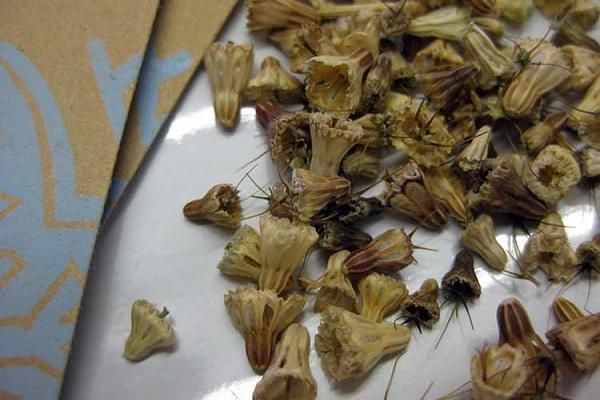

Airing
The film must be removed from the container for two hours every day. This will allow air to enter the soil and prevent rotting. It is imperative to ensure that condensation does not appear, as it causes mold on the soil. After the appearance of a larger number of seedlings, the film is removed.
Dive
As soon as the first pair of true leaves appear on the sprouts, the plant is dived into a separate container. If a common box is used, then a distance of at least 6 cm between the shoots is maintained.
A week before transplanting to an open area, the seedlings begin to harden. A container with seedlings is taken outside daily. The time spent in the fresh air is increased gradually.
Landing in open ground
In the last days of May, seedlings are transplanted into open flower beds. The soil on the site must first be dug up and fertilized. Make holes 16 mm deep at a distance of 32 cm and plant seedlings. The first time at night it is better to cover the planting with a film.
See also
15 best types of kandyk varieties Pagoda and their description, planting and care in the open fieldRead
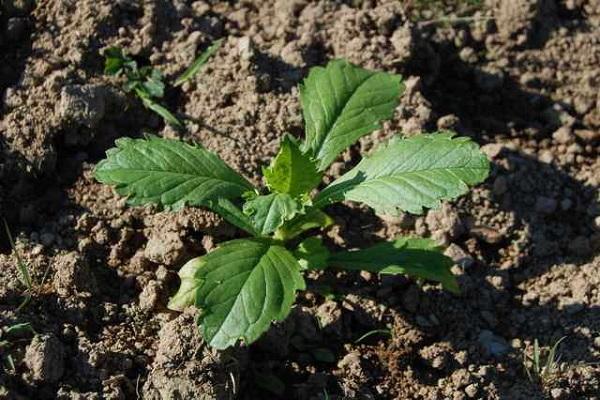

Planting scabiosa seeds in open ground
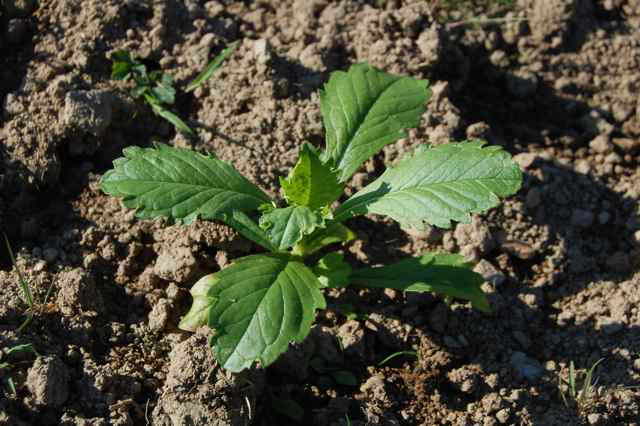

How to plant scabiosa seeds in the ground
- Sowing seeds of scabiosa in open ground is carried out in the spring (end of April).
- Dig up the area, level the ground, spread the seeds over the surface, moisten, cover with a layer of compost on top.
- Seedlings will appear after 10-15 days, when they grow up a little, carry out thinning.
Botanical dossier
Scabiosa is a perennial herb or an annual with a lignified rhizome. The foliage in most species is slightly pubescent and partially divided into lobes, but there are also plants with simple smooth leaves.
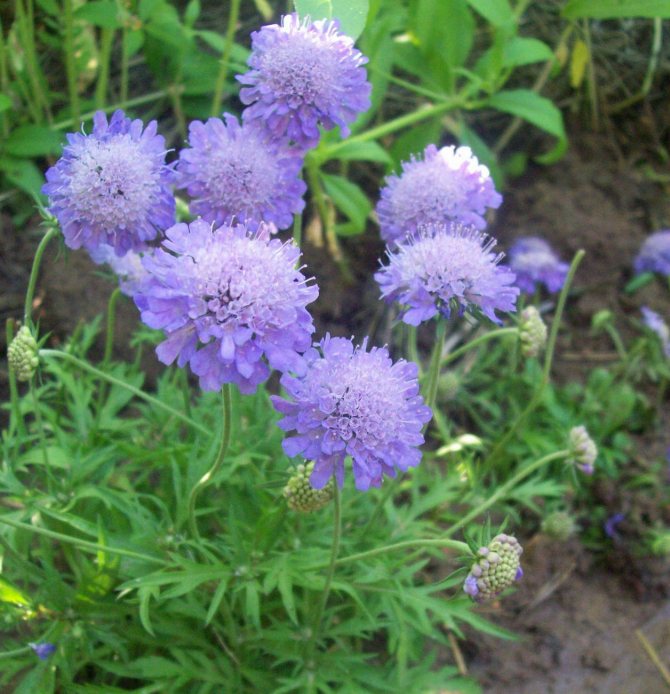

The flowers are small, tubular, collected in capitate inflorescences, in which the size of the outer flowers, located around the circumference of the saucer-shaped bracts, is much larger than the size of the inner very miniature flowers.
In several species, the inflorescences are sessile, but in most they are crowned with a high peduncle.
The color of the heads in natural species varies from lilac-blue, lilac and cream to purple, and in varieties the palette of inflorescence shades is much wider.
The plant blooms in the second half of summer and until mid or even late autumn.
Seed planting in open ground
If the climate permits, the spring turned out to be early and warm, you can not waste time growing seedlings and sow seeds directly in the flower garden. It is best to do this in mid-April if there is no risk of night frosts.
Location selection and lighting
Scabiosa can only grow well in bright areas. Therefore, you need to choose a sunny place for sowing. It must be protected from strong winds. It is better that the site is elevated without closely located groundwater. Scabiosa does not like swampy ground. Therefore, it must be well equipped with a drainage system. This is especially true for perennials.
Landing rules
In order for scabiosa to grow well and bloom profusely, you need to prepare fertile, loose soil before sowing. It should be neutral in acidity. In acidic soils, the plant may die. It is recommended to dig up the site in the fall. 2 weeks before sowing, the site must be cleared of weeds, loosened up the soil.Make shallow grooves at intervals of 35-40 cm, water. Lay out the seeds, keeping a distance of 5 cm between them. Sprinkle with soil. When the seedlings grow up, they need to be thinned out, leaving the strongest specimens with intervals of 30 cm between each.
Growing seedlings from seeds
Scabiosa can be grown in different ways. The most commonly used seed. You can sow seeds directly into the ground or on seedlings. In temperate climates, it is preferable to grow the flower in seedlings. The best time to sow seeds for seedlings is late March and early April.
Soil and capacity
Prepare a low container. Fill with multi-purpose soil mixed with sand (2: 1). Disinfect it by steaming in a water bath or using a potassium permanganate solution. Tamp and level the soil a little. Make grooves, sow seeds to a depth of 0.5 cm. Spray crops with a spray bottle. Cover the top of the container with foil or glass. Place in a bright place at a temperature of + 20..22 ° C.
Seedling care
Seedlings may appear after 1-3 weeks, depending on the type of scabiosa. The shelter must be removed daily to ventilate and remove condensation. When sprouts appear, it can be removed. Make sure that the soil is moist, but do not swamp it. Light for seedlings needs bright, but diffused.
After the formation of 2-3 true leaves, the seedlings dive into individual pots. After that, the seedlings must be hardened. She is taken out into the street at first for 1 hour. The hardening time is gradually increased.
Transplanting
On the site, seedlings are planted at the end of May - at the beginning of June. Before planting, it is recommended to fertilize the soil with rotted manure. Prepare holes so deep that the seedlings fit in them along with the earthen clod. The optimum distance between plants is 20-25 cm. Carefully remove the seedlings from the pots so as not to damage the roots. Place in the hole, lightly press down and sprinkle with soil.
Natural species of scabiosa
The flowering of our perennial plant is long and abundant (the same is characteristic of mallow). In addition to their beautiful appearance, flowers have medicinal properties. It was believed that the plant is able to cure scabies, because the literal translation of scabiosa is "scabies". All types of plants are unpretentious in care.
Pigeon
Mountain species of scabiosa. It reproduces by self-seeding. Bushes can be found along the banks of streams, in meadows, among bushes. Quite a rare flower.
The flowering period of perennial or two-year pigeon scabiosa lasts from early summer to autumn. The long stem of the plant reaches a height of more than a meter, is slightly pubescent and has branches upward. Leaves are oblong or pinnately-divided. The calyx is brownish-red or purple with bristles and is 5 mm long. The flowers are quite large.
Japanese
When grown by seed, the seeds of this scabiosa are planted in the soil in May, and when grown by seedlings, in March. The variety is resistant to temperature extremes, tolerates light aridity well, but does not tolerate waterlogged soil. Therefore, it must be grown on well-drained soil. The Japanese use flower leaves and roots to make medicinal potions.
Caucasian
The plant reaches a height of 60 cm. The tall, erect stems of scabiosa are covered with lavender or pale blue flowers, which bloom up to 8 cm in diameter. Flowering begins quite late, only in late summer and continues until late autumn. The pleasant smell of the flowers attracts insects that pollinate the flowers.
Purple
The species differs from all in that it has very fragrant snow-white, purple, blue and pink flowers. On the sinewy legs of the branchy plant are jagged vertical leaves reaching a length of 5 cm. The diameter of the scabiosa flowers reaches 2 cm. Neutral soil with normal acidity is suitable for cultivation. Distributed throughout southern Europe.Purple scabiosa is an annual plant, although there are perennial species as well. Thanks to its unusually beautiful flowers, it is liked by gardeners and gardeners and is used to decorate flower beds in their summer cottage. This scabiosa will not grow in alkaline soil. Add a little lime to lower the alkaline level.
Cereal
Attractive inflorescences of a pale blue or silvery white shade, beautifully scattered on stems up to half a meter high. Propagated by seeds. Used to decorate a rocky garden.
Pale yellow
Even a novice florist can grow this scabiosa from seeds. This plant does not need any special conditions of detention. It thrives on poor soil as well. Propagated by dividing the bush. Small inflorescences, yellowish-creamy, give the plant a decorative effect.
With good care, scabiosa flowers grown from seeds adorn the flower bed from early spring to late autumn.
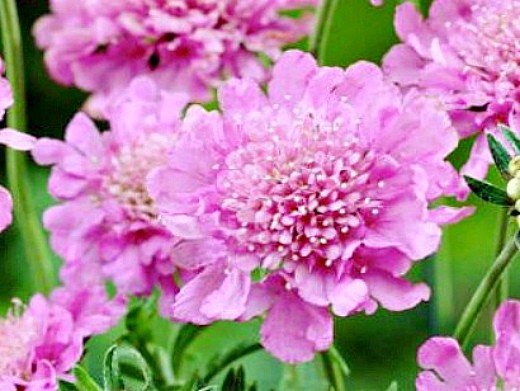

Growing scabiosa from seeds for seedlings at home
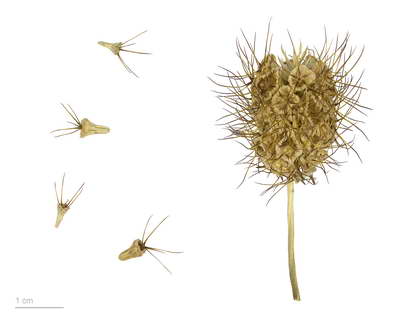

Scabiosa seeds photo
When and how to plant scabiosa seedlings
In the conditions of central Russia, the optimal method for propagating scabiosa is growing seedlings from seeds. Sowing is carried out in late February - early March.
- You will need wide containers (or seedling trays) and a loose nutrient medium (most commonly soil made for growing seedlings).
- Fill the container with soil, level it, gently distribute the seeds over the surface and lightly sprinkle it with soil on top, spray the crops from a fine-dispersed sprayer.
- If you do not like to dive plants, plant 1-2 seeds at once in the cells of the seedling cassettes. Once the plants have risen, they can simply be transferred into larger pots.
- Cover the top with clear glass or plastic wrap. You will need diffused lighting and an air temperature of 15 ° C, raise the shelter daily for ventilation, periodically moisten the soil surface by spraying.
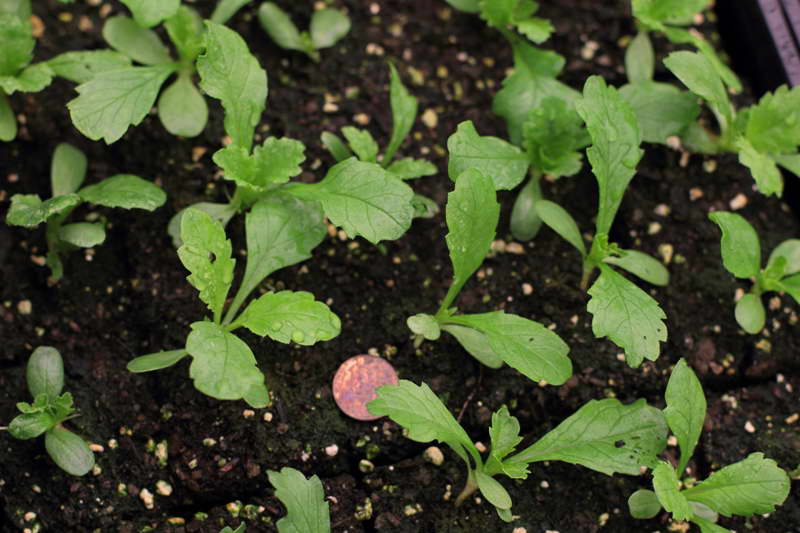

Scabiosa seedlings photo
- With the emergence of seedlings, the shelter can be removed.
- After the formation of a pair of true leaves, plant in separate pots.
- Grow with moderate watering and diffused lighting.
Hardening
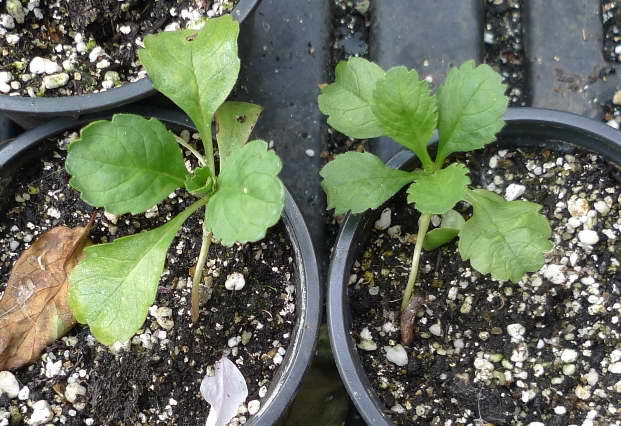

Scabiosa seedlings photo
A couple of weeks before transplanting into open ground, which is carried out with the establishment of real heat (approximately, mid-end of May), start hardening the seedlings. Move the pots with plants to fresh air, first for an hour, gradually increasing the length of time until the seedlings can spend the night outside.
Planting seedlings in the ground
Make holes according to the size of the root system, transfer the seedlings together with the earthen clod, the root collar should be flush with the soil surface. Squeeze the ground around the seedling with your hands. Keep a distance of 30-35 cm between individual plants, do 40 cm aisles.
The best varieties
Currently, there are up to 100 species of scabiosa, some of which were relatively recently isolated into a separate genus - Korostavnik. In general, most varieties of the crop are obtained through breeding and are considered garden varieties that do not occur in nature.
Caucasian scabiosa
The plant is widespread in the mountains of the Caucasus, Turkey, Iran. It differs in large inflorescences up to 7-8 cm, densely located on stems 60-70 cm high. The color range is shades of lilac, long flowering - from July to September. It is a perennial, but can be grown as an annual crop. Hybrid forms that give white, pink, blue, purple flowers are popular - Nachtfalter, Fama, Compliment, Blauer Atlas, Perfect and others.
Caucasian scabiosa is used more often than other species in landscape design:
- Include in mixborders, ridges, alpine slides;
- Planted along hedges and paths;
- They create solo compositions in separate containers;
- Grown to cut for bouquets.
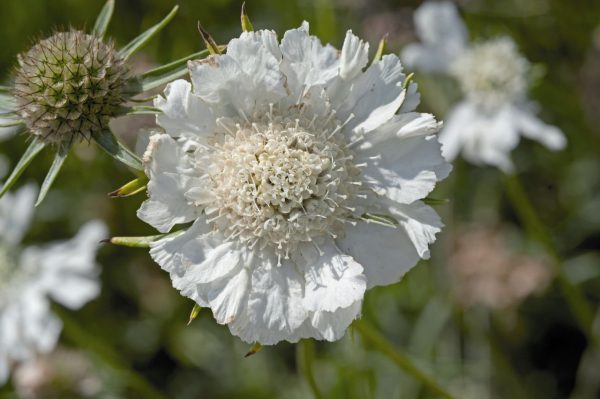

Scabiosa caucasia Fama White
Japanese scabiosa
A perennial plant native to the Japanese islands. A frost-resistant species that is perfectly cultivated as a biennial in central Russia. Stunted due to natural growing conditions - up to 60 cm. Some varieties do not exceed 20 cm. Flowers of red and pink shades in diameter of about 5 cm. Bushy, uniform flowering lasts from late June to September.
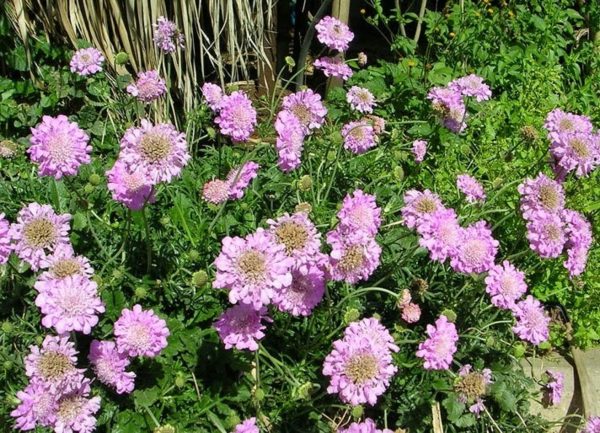

Scabiosa japonica Pink Diamonds
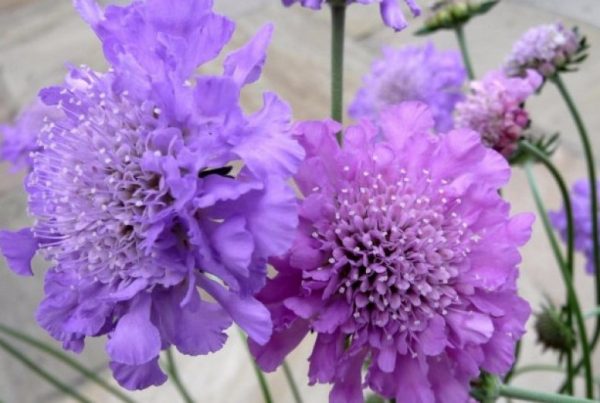

Scabiosa japonica Romance
Scabiosa yellow
Originally from Europe, however, in Russia it is quite rare - in several regions it is listed as a wild species in the Red Book. Quite a large perennial, up to 1 m in height under favorable conditions. Stems are erect, powerful, but require additional support in strong winds. The flowers are pale yellow and bloom peaks at the end of summer. In landscape design, it is usually used as a backdrop for more vibrant crops.
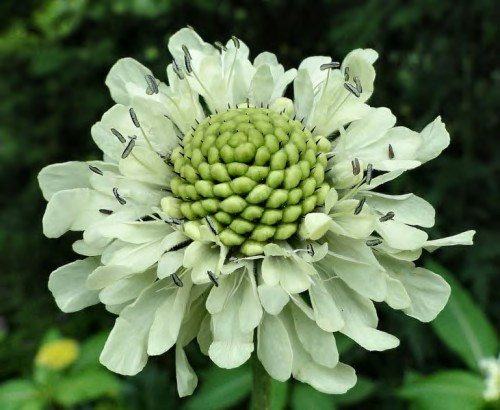

Scabiosa ochroleuca moon dance
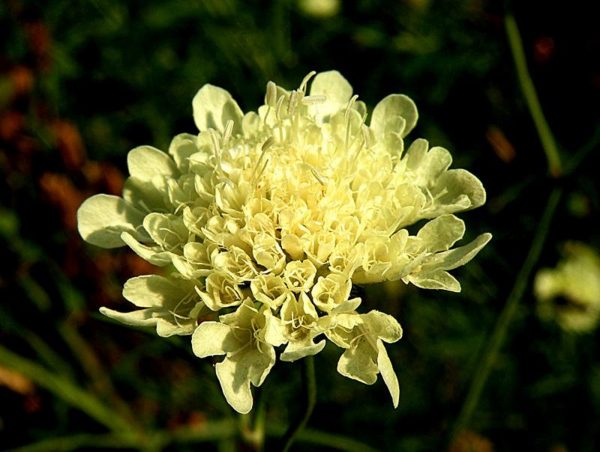

Scabiosa ochroleuca Pixie Yellow
Scabiosa stellata
It is an annual also known as stellate scabiosa. It is not so much the pale blue flowers that are valuable in it, but the unusual bracts that form after the petals fall off. This is what distinguishes the stellata from other types - beautiful balls, consisting of golden bracts, shaped like paper funnels. Culture looks great in any mixed composition, be it a modest bouquet or a mixborder. Its height is no more than 60 cm.
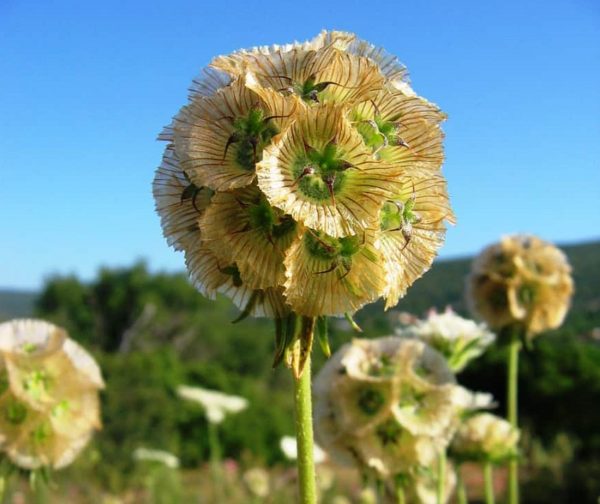

Scabiosa stellata after flowering
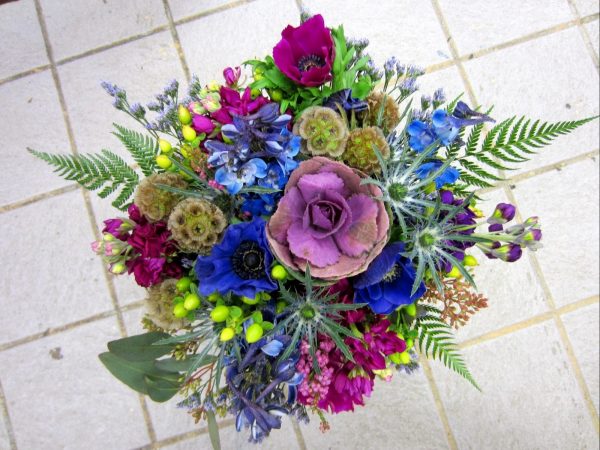

Bouquet with stellate
Scabiosa purple
Annual, less often biennial culture. It is valued for its brightly colored burgundy flowers; in some specimens, the color may be close to black. The plant has powerful pubescent stems up to 110 cm tall, inflorescences about 7-8 cm - exude a strong aroma. Some hybrids are undersized. Unlike other species, purple does not tolerate negative temperatures, therefore it grows well in the south. Long bloom - up to 2 months, starting in July. In Europe it is known as the "flower of mourning" or "Egyptian rose".
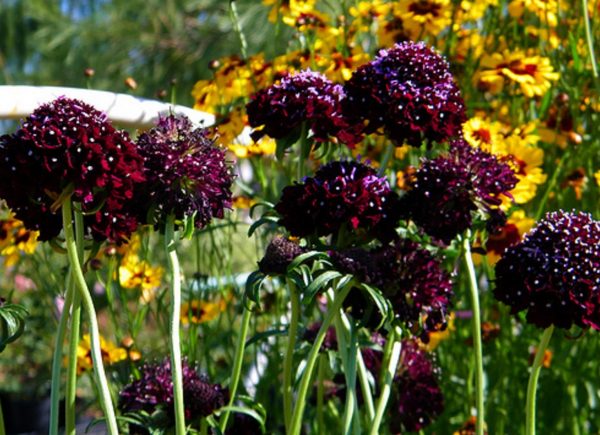

Scabiosa atropurpurea Ace of Spades
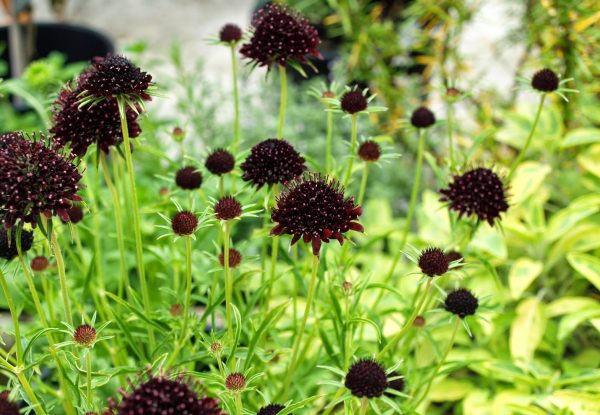

Scabiosa atropurpurea Chile Black
Scabiosa terry
May refer to any of the types listed above. Its varieties have large, well-pubescent inflorescences, the color of which varies depending on the variety. Among them are Fruit Ice, Lavender Lady, Crystal and others. Terry scabiosa is in demand in landscape design and bouquets.
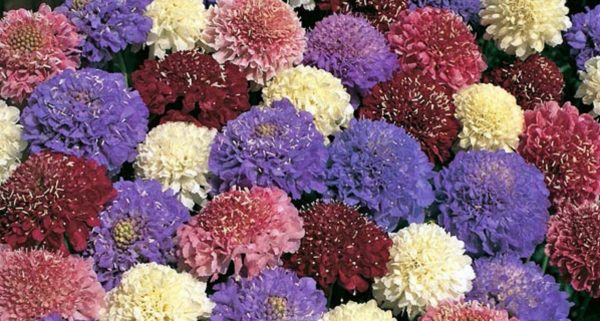

Fruit ice mix
Video - Scabiosa
Healing properties
In folk medicine, scabiosa "coronal" is used, due to the inclusion in the composition of steroids, phenolcarboxylic acids, alkaloids and flavonoids. Beneficial features:
- antipyretic;
- disinfecting;
- diuretics;
- emetics.
Medicines based on this plant are used to relieve digestive system disorders. They help to treat pneumonia, pulmonary tuberculosis, pathologies of the urinary organs, and alleviate the condition of cardiovascular diseases. Used to rinse a sore throat with sore throat. Allows you to get rid of warts and abscesses.
general characteristics
This plant is suitable for creating meadow alpine slides and mixborders - flower beds resembling a meadow in style, as well as just for variety and shading of large flowers. It gets along very well with neighbors. Most likely, this plant does not solo in a flower bed, but, without a doubt, it gives a special charm and brings a new mood.
Habitat and origin
The name comes from the Latin skabies - "scabies". In ancient times, decoctions from this plant were used in the treatment of skin diseases. They also called Butylnik, Korostavnik, Sverbezhnitsa, Sinyavka and Breast Grass.
Belongs to the genus of herbaceous or semi-herbaceous plants of the subgenus Vorsyankovye and the genus Honeysuckle. Scabiosa is basically a perennial plant, but it can be annual or biennial.The annual has also the name Korostavnik Polevoy.
Previously, it grew in meadows and in natural conditions in Eurasia, South and East Africa (in the mountains), the Mediterranean. Preferably on calcareous soil. Now breeders have bred more than 100 species and scabiosa is successfully used as a decorative flower.
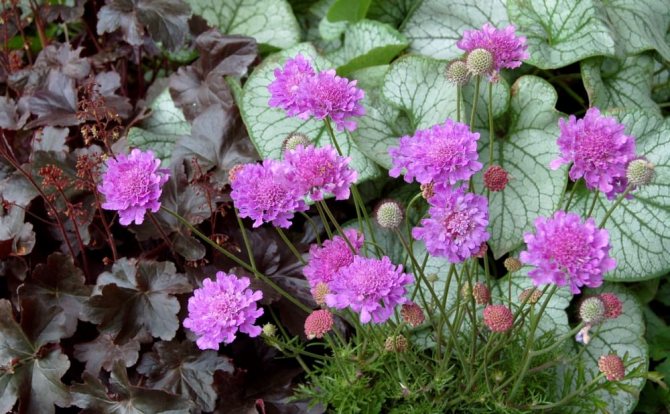

Botanical description of the plant
Many call the flowers of scabiosa "pumpkins" and, indeed, it immediately becomes clear what is at stake. Shaggy "balls" - inflorescences are familiar to many growers.
- The leaves are pinnate, serrated or lobed, placed oppositely on a bare stem, the height of which is from 10 - 15 cm to one meter. The leaves may differ slightly depending on which species it belongs to.
- The flowers are combined into heads with a light grassy cover. The calyx consists of 2 parts: the outer one with 8 well-developed ribs and is covered with a dryish film along the edges. The inner bell-shaped and saucer-like, five-toothed.
- The whisk consists of 5 sections. Two or four stamens.
- The fruit, the achene, is a simple, unopened dry with a leathery pericarp. The seeds are brownish, oval and small. There are about 350 seeds per 1 gram.
Larger than the rest of the inflorescences are those at the edges. Flowers come in a variety of tones: white, pale yellow, lilac purple, blue, pink, crimson. From July to September, scabiosa begins to bloom actively.
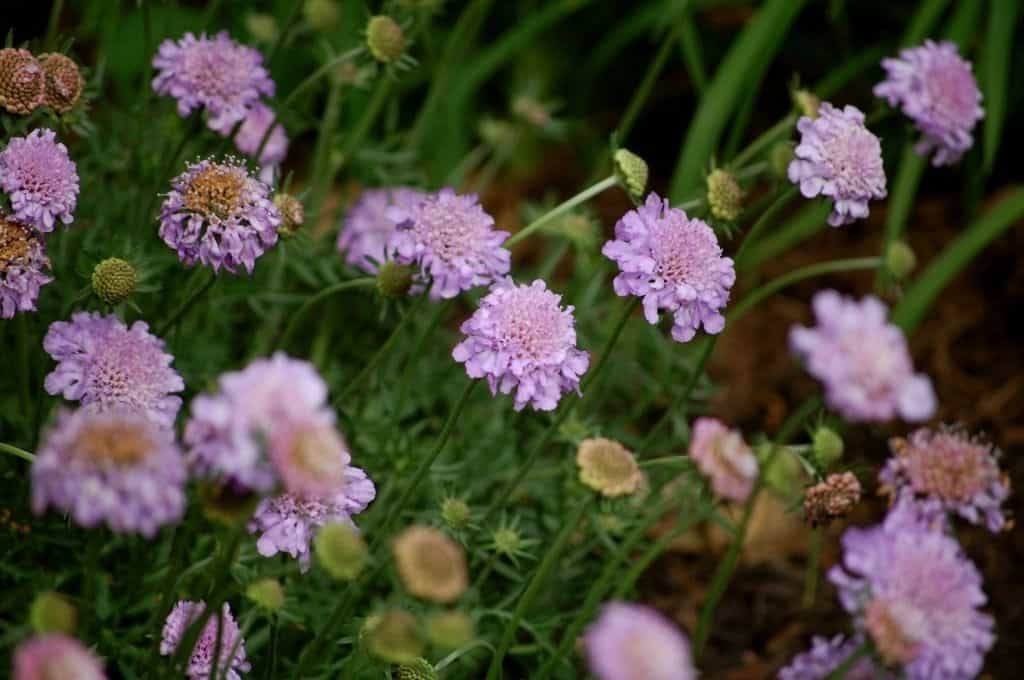

Growing
Watering and feeding
The flower needs to be watered regularly during a drought, if the leaves hang sluggishly, this means that the plant does not have enough moisture. Waterlogging should be avoided and the soil should be well drained. Especially immediately after planting a new bush, a lot of water is needed to feed the roots.
In the case of perennials, fertilizer can be applied in the form of compost, but a slow-release perennial fertilizer that provides plants with nutrients throughout the summer has also proven beneficial.
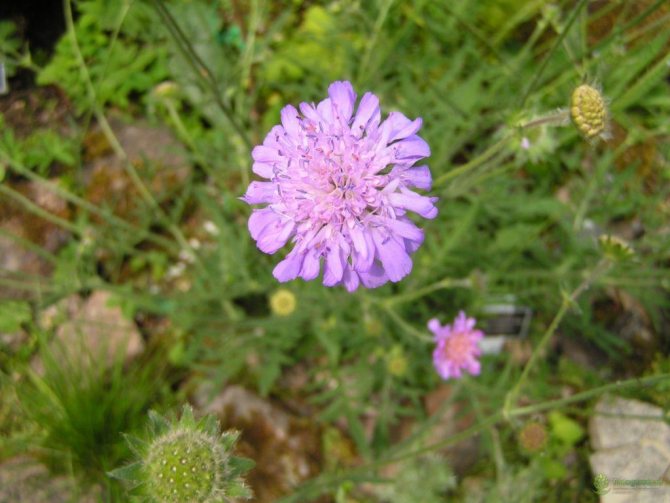

Scabiosa works very well as a gap filler and takes away little nutrients from other plants
In another article, we described another perennial variety - Edelweiss.
Outdoor care
After planting, caring for the plant on the site does not require complex manipulations. Scabiosa is absolutely not whimsical, it can tolerate drought and cold snap.
Watering
The flower needs moderate watering. It is not necessary for the soil to remain wet all the time. It is enough to water the bush once a week if there is no rain. But if it is hot dry weather, then it is doubled. After watering, the soil should be loosened.
Top dressing and fertilization
During the growing season, scabiosa needs regular feeding 2 times a month. You can take any universal mixture for ornamental crops. Organic matter can be applied only before planting. At the flowering stage, potassium-phosphorus fertilizers are applied weekly.
Care during and after flowering
The flowering time of scabiosa can be different, depending on the variety. As a rule, this is July-August. The flowers are collected in capitate inflorescences that form on long peduncles. Their color can be varied.
Pruning
In order for the scabiosa to remain attractive until late autumn, she periodically needs to be pinched. This stimulates the growth of young side shoots and improves bushiness. All dried branches and flowers should be cut out immediately. At the end of autumn, the stems of perennial species are completely cut off.
Loosening the soil
The soil under the bush should be regularly loosened and weeded. This is necessary for better oxygen penetration to the roots, the scabiosa will grow better.
Diseases, pests
Insects rarely annoy the tease, but excessive watering and cold rainy seasons often lead to putrefactive processes, the plant loses its decorative effect, gets sick and dies. This is often provoked by thickening of the planting and poor weeding, which should be timely and obligatory for this crop.
One of the common troubles is the defeat of powdery mildew, the infection is easily transmitted with insects. This is especially dangerous when the weather is colder than +20 C and frequent rains. To eliminate the problem in the early stages, it is recommended to use preparations containing sulfur. Processing must be done at least twice. Severely affected crops will have to be destroyed, followed by sanitizing the site with fungicides.
Scabiosa inflorescences can stand for a long time in the cut, remaining fresh for up to a week or more.

